DeSci – (How) Will It Make Research Great Again?

Partners
-

AsteriskDAO - Disease-specific data lakes for female-biased disorders.
Visite website -
Data Lake - building blockchain tools to solve the $100 B problem of patient recruitment into scientific trials.
Visite website -

Etica - a decentralized protocol funding open source medical research without intellectual property.
Visite website -

Welshare Health - The web3 app to personalize your contribution to medical research.
Visite website
Key takeaways
- Any entrepreneur who wants to build a meaningful, Web3-based project should look at DeSci. The field holds high potential for both academia and business. It’s already battle-tested (though at a small scale), promises to create significant real-world change, and has an established non-degen community.
- The application areas where DeSci’s contribution is most fruitful are data sharing, research marketplaces, and facilitating collaboration between researchers. This includes commercial and scientific research, private and institutional.
- At present, the one industry that benefits from DeSci and attracts Web3 entrepreneurs and scientists is healthcare. To some extent, the idea also gains traction in open publishing. However, in the long run, DeSci could become relevant for more sectors. The report explores which.
- Enterprises are starting to explore DeSci-oriented innovations, e.g., incentivized, collaborative research, incentivized data collection from users, etc. You’ll find the most popular platform models described in the report.
- DeSci can modernize and reform completely outdated processes of traditional science (TradSci) and revive a field that has been losing relevance and credibility.
- The future of DeSci in academia depends on the scale of adoption. Projects like Bloxberg which connects researchers and universities using blockchain are a good start. When the academic world moves onchain, the rest is more likely to follow. Time to get involved with DeSci.
Why is this report urgent?
The 20th century treated humanity with an unprecedented amount of innovation and scientific discovery: antibiotics, transistors and semiconductors, genetics, modern computers and the Internet—to name a few. All these transformed the way we live and do business.
Looking at the 21st century alone reveals an entirely different picture. Besides AI—which dates back to the previous millennium—or advancements in renewable energy, not many significant scientific breakthroughs have changed our lives.
Science and research don’t seem to be disruptive anymore and don’t seem to influence businesses much.
But the millennium is still young. Some modern innovations have yet to be adopted. One of them is blockchain.
In 2017, the Decentralized Science (DeSci) movement promised to revolutionize stagnating scientific processes and structures. The idea was to create an equal playing field for all curious minds, ready to research whatever intrigues them. The concept incentivizes them to work, discover, and collaborate with the help of multiple Web3-based mechanisms.
This paper reevaluates DeSci’s promise and assesses its current state. The Onchain research team explores the question, “Can DeSci help the world of research make a real-world impact?” You will discover businesses and industries where this is likely to occur. You receive an analysis of Web3 mechanisms underlying DeSci projects.
Join our quest for a perfect solution that will benefit not only academia but also businesses. And discover how you can get the most out of this exciting field as a builder, user, or contributor to DeSci.
Where is the impact?
Science is not disruptive anymore. A study published in the renowned science journal Nature supports this statement. It exposes a sad truth about the world of science and raises questions about its purpose.
In their research, the scientists used a specific “CD” index as a “disruptiveness” score for the discovered innovations. They could then demonstrate that the impact of papers and patents decreased significantly over the last decades, regardless of the field.
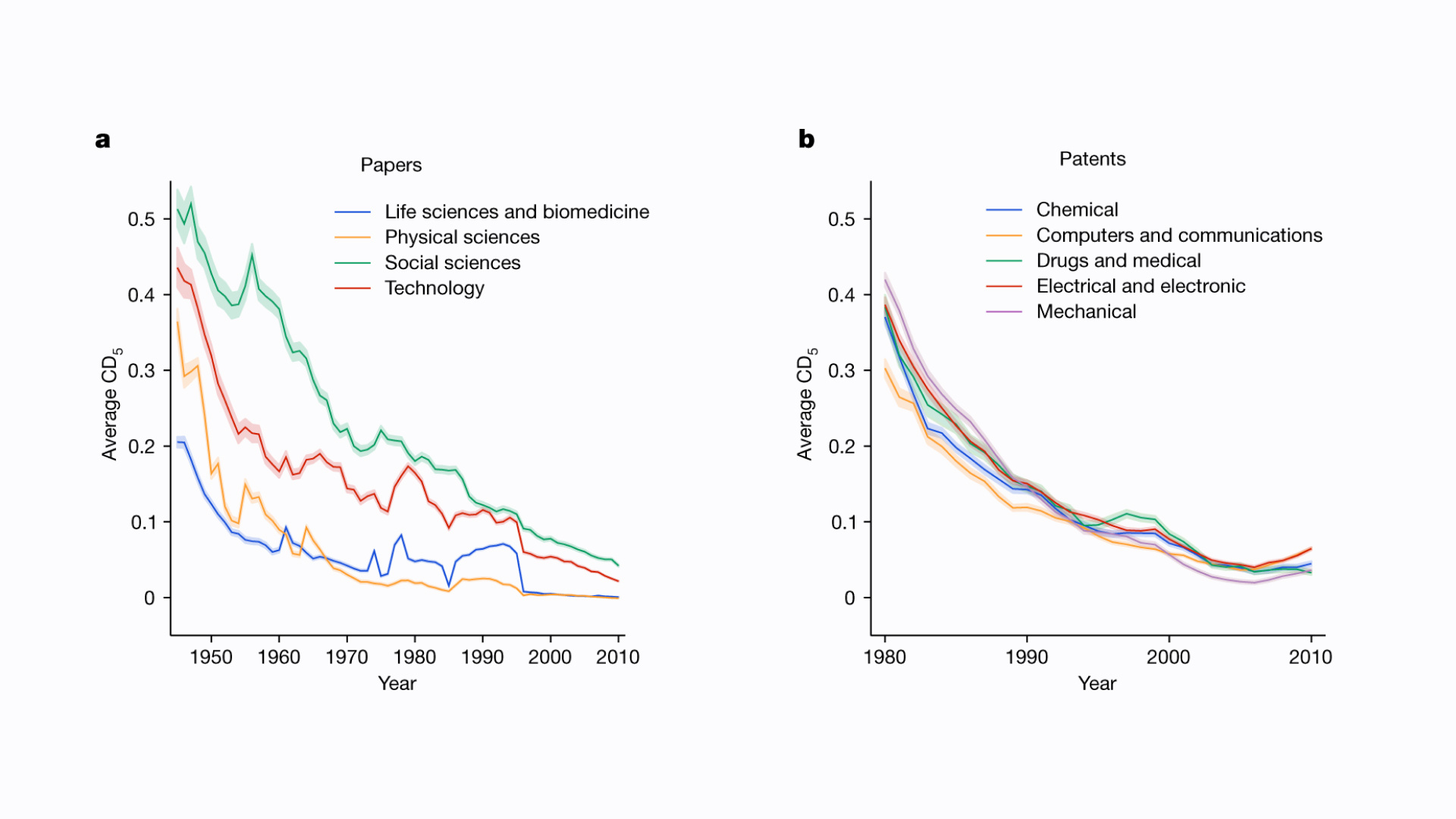
Source: Park, M., Leahey, E., & Funk, R. J. (2022). Papers and patents are becoming less disruptive over time. Nature, 613(7942), 138-144. https://doi.org/10.1038/s41586-022-05543-x
Although unpopular among academics, this view is not isolated. More than ten years earlier, in 2011, a similar study conducted specifically on research of European origin also revealed a negative trend.
Moving further back in time, we find that John Horgan’s famous 1996 book already predicted “The End of Science.” Oswald Spengler had prophesied the same as early as 1923. He devoted a significant part of his famous “The Decline of the West” magnum opus to the challenges of scientific activities.
What are the reasons for such a bleak outlook at the most fruitful time for scientific research? That depends on who you ask. But there’s probably a bit of truth in each argument. You can compare them below.
1. “Papers and patents are becoming less disruptive over time”
Author(s): Park, M., Leahey, E., & Funk, R. J. | Year: 2022
Why is science falling?
Researchers focus on specialized, narrow areas – hence losing track and understanding of the “big picture.”
2. “The Resistible Decline of European Science”
Author(s): Bauwens, L., Mion, G., Thisse, J. | Year: 2011
Why is science falling?
The lack of funding and collaboration among Europe-based researchers as compared to US Universities.
3. “The End of Science”
Author(s): Horgan, J. | Year: 1996
Why is science falling?
All significant developments have already been discovered and implemented. We’re left with incremental innovations only.
4. “The Decline of the West”
Author(s): Spengler, O. | Year: 1923
Why is science falling?
Science is just another “cultural construct,” the same as art or music. Hence, it won’t result in many groundbreaking papers but rather in a massive amount of articles relevant only to their authors.
The top 5 challenges of scientific research
What if the downtrend of scientific impact is an optical illusion, and we’re simply unaware of the most significant breakthroughs? After all, the internet needed 30 years to break into the mainstream. Who knows what scientists are cooking for the year 2050?
The truth is, it’s not easy to find positive signs for the future of research when considering the struggles of its academic branch. What’s worse, there’s hardly any attempt to address the challenges that remained relatively unchanged over the last few decades:

Challenge 1: Research material is difficult to access
-
- There’s no open access to academic research papers.
- Publishers place research papers behind paywalls to generate income, thereby limiting access.
- Articles are often unaffordable for individual researchers due to high prices (e.g., 1 article from the Journal of Marketing = 29€ for 24-hour access).
Such obstacles have also been confirmed by DeSci Founders we interviewed for this report:
Traditional publishing houses charge between $2,000 and $11,000 per paper, with open access fees ranging from $2,000 to $4,000. If authors don’t pay these fees, readers must pay $50 to access the PDF, with all proceeds going to the publishing house. – Maria Goreti Freitas, Leader of deScier.
Challenge 2: The majority of research papers lack real-world impact
-
- Paper reviews conducted by academics focus on retaining the status quo rather than challenging it.
- Researchers use the same tools and methods repeatedly to increase the chances of positive reviews.
- A point system for academics encourages researchers to prioritize quantity over quality. Points are gained with frequent publications, and a low number of publications may result in dismissal from academia.
Challenge 3: Research results lack reliability
-
- Researchers strive to achieve extraordinary results to capture attention and increase the chances of becoming accepted in journals.
- Researchers avoid results that don’t prove the initial hypothesis due to being perceived as less influential despite often being more representative.
- Reproducibility crisis – the majority of results can’t be reproduced which casts doubts on their accuracy.
- Paid journals where researchers practically pay for placements are gaining popularity.
Challenge 4: Collaboration and synergies are not encouraged
-
- Researchers prefer to publish papers alone or in small groups because it allows them to retain the total amount of points.
- The number of open datasets and sources on which researchers can collaborate is limited.
- Collaboration elements (e.g., peer reviews) are generally non-paid, so there’s no incentive for people to cooperate more frequently.
Challenge 5: Academic publications ignore the reader’s perspective
-
- The language used in academic papers is highly sophisticated and often overly complex, making it difficult to attract a broader audience.
- Academic journals have yet to adapt to the internet and digital media, holding on to formats common in the 1950s. The authors forget about web writing and the general preferences of today’s audience.
It’s not surprising that even seasoned scientists, such as Maria Goreti Freitas from deScier, decide to move from traditional science to less conventional spheres of research:

I’ve been a scientist for 40 years. And these challenges (that I’ve basically faced already during my 1st career in academia) led me to build and offer an alternative solution for scientific publications: The DeSci (not TradSci) journals.
Our survey of 365 business representatives confirmed the challenges of obtaining valuable scientific research—especially for business purposes. Respondents named data access difficulties and insufficient expertise to extract insights from cumbersome papers as top challenges. These are in addition to the cost and reliability issues we already mentioned.
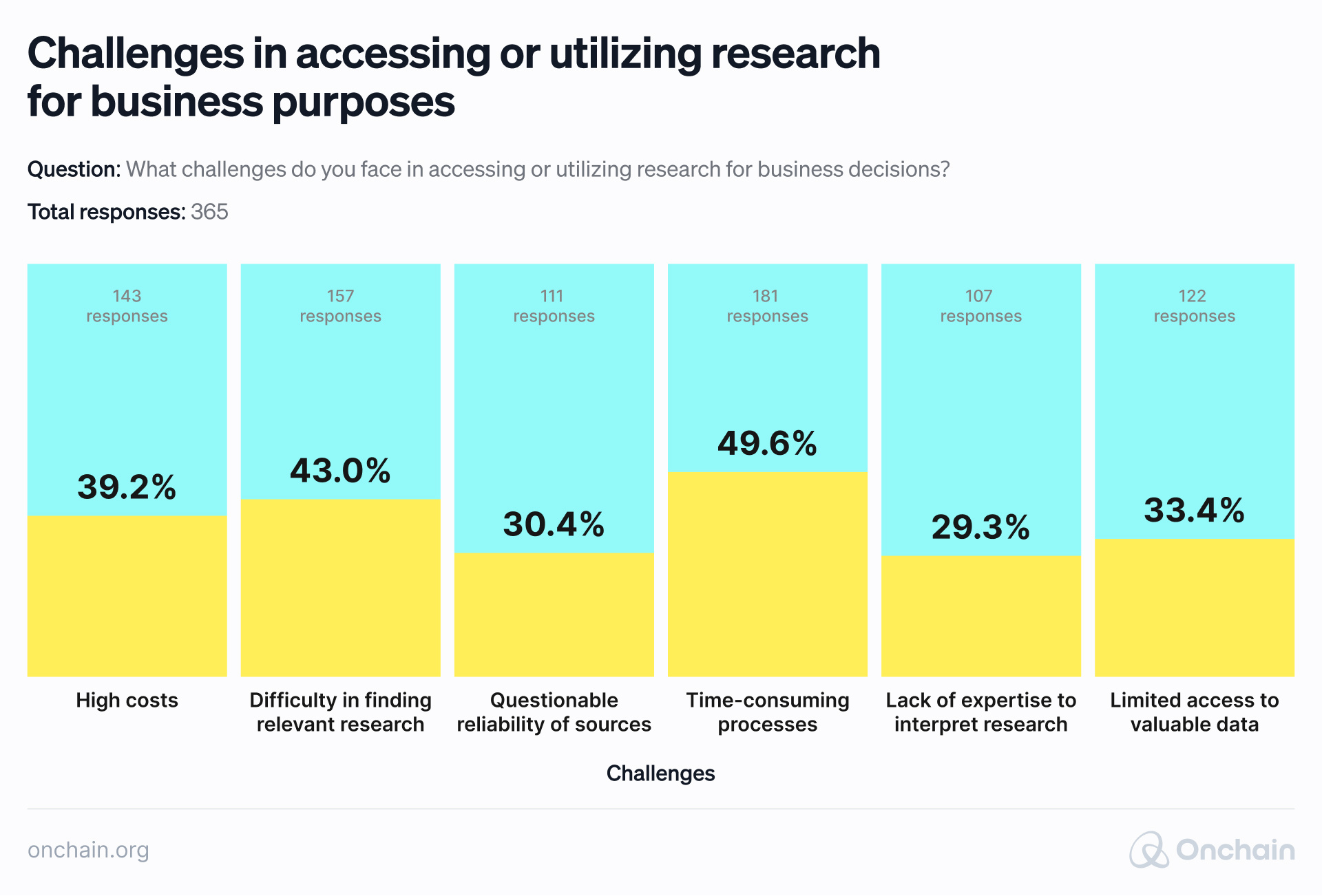
The findings are cause for concern. As you can see from the graph below, the vast majority of businesses use research to make informed decisions, setting aside the limitations. This highlights the pressing need to develop accessible, cost-effective research tools and platforms to support these companies.
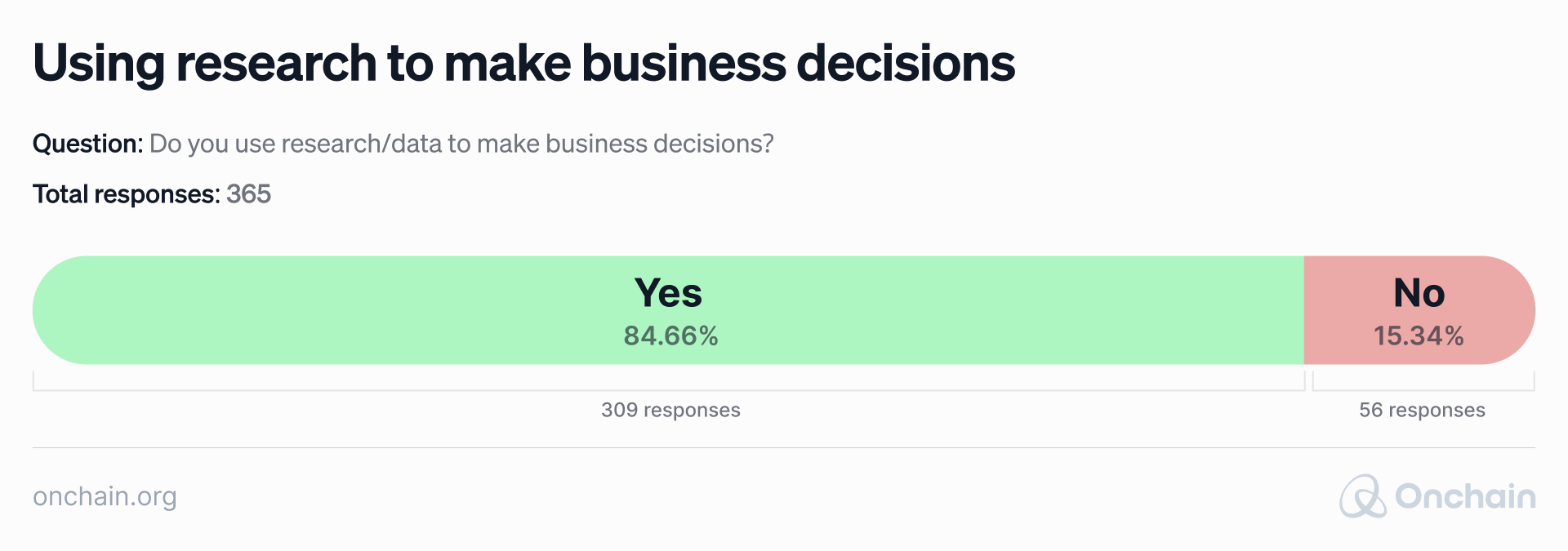
To better understand the demand, let’s look at the purpose of research outside the academic world. The responses from the same survey indicate a wide range of possible uses in decision-making processes. An equally high percentage use research for company or product-specific purposes. However, a notable portion still does not use research, which suggests growth opportunities in this area.
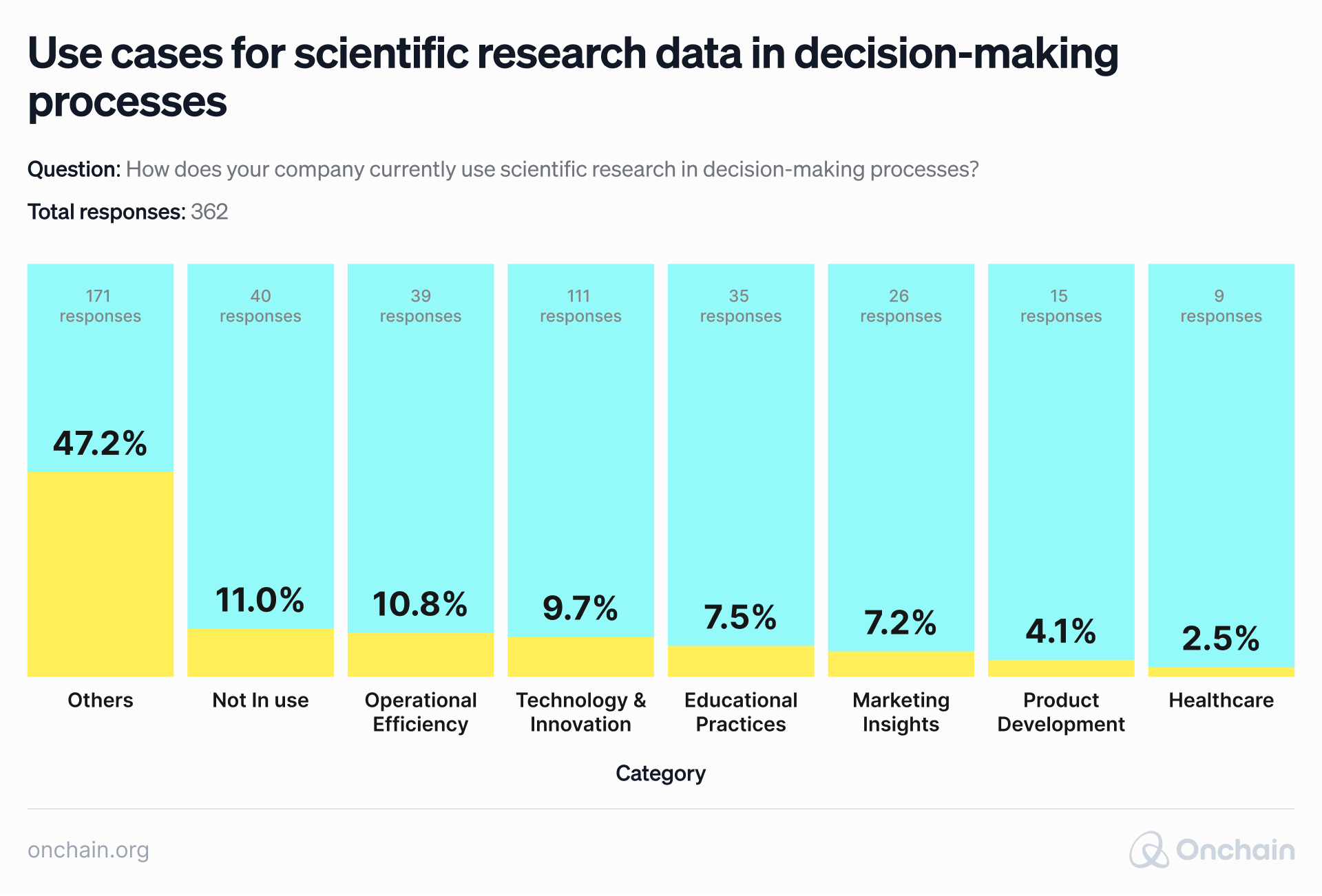

Is the right to intellectual property or human rights more important to you?
Sponsored content by Etica
Intro
To understand what Etica is trying to fix, it is important to understand what are some problems with medical research:
- Many studies are poorly designed in order to promote an agenda.
- Replicating results is necessary for good science, but rare
- Peer review has many shortcomings
- Too much science is locked behind paywalls
- Intellectual Property is slowing down science and creating inequalities
The pharmaceutical industry is a massive global business, worth billions of dollars each year. It is made up of numerous companies that develop, manufacture, and market drugs and medical devices. Corporate interests play a significant role in the pharmaceutical industry, as these companies are driven by the need to make a profit. This profit motive can sometimes conflict with public health interests.
Challenges in obtaining research funding
One of the biggest challenges for medical scientists is to find a sustainable source of funding. In most places around the world, Governments or public organizations provide funding for medical research, which is good, as there are fewer chances of conflict of interest, but there is not enough. This means researchers will then look for private funding, which will only support science if it supports their corporate agenda. This is catastrophic because it means that some science is guided not by what is good for society/humanity in terms of science, but by what will make the most return on investment to these private funders. Much of nutrition science is funded by the food industry, and this is a major conflict of interest, food companies will not change the results of research, but they will not fund something if the hypothesis goes against their interests, thus shaping how science evolves.
A significant portion of healthcare spending is on drugs to treat conditions like type 2 diabetes, hypertension, and high cholesterol, which are largely caused by poor diet and a lack of exercise. Implementing policies like stricter regulations on unhealthy foods and drinks, subsidized healthy school meals, and courses on preparing nutritious and affordable meals can help people lose weight, making drugs unnecessary. The research done by pharmaceutical companies is often focused on profitable markets. Only around 1% of newly developed drugs in the late 20th century were for tropical diseases like African sleeping sickness, dengue fever, and leishmaniasis. As a result, only a single new drug has been introduced in the past 50 years to treat tuberculosis, which claims the lives of millions of people each year.
Since scientists have to compete for this finite and decreasing amount of funding (at least for public funding), it creates conflicts of interest between scientists of the same field, puts pressure to publish many papers instead of a few quality ones, and forces scientists to oversell their work (use buzzwords to get funding). This competition between scientists for funding affects what people study, the risks they take, and the risks they don’t take, overall it pushes researchers to do predictable, safe, and hyped science. On top of that, grants are usually short-term (3-5 years), which means that scientists are less likely to apply for long-term projects, even though these are usually the ones that create the biggest discoveries. All this pushes scientists to submit repetitive, short, safe studies.
Repetitive results and lack of trust
Medical researchers are judged by the research they publish, and they have tons of pressure to get certain types of results. If you get good splashy results, it will be easier to get published in a prestigious journal, but if they get mediocre results, many scientists consider presenting the data differently to keep it exciting. “The consequences are staggering. An estimated $200 billion — or the equivalent of 85 percent of global spending on research — is routinely wasted on poorly designed and redundant studies, according to meta-researchers who have analyzed inefficiencies in research. We know that as much as 30 percent of the most influential original medical research papers later turn out to be wrong or exaggerated.”
Interoperability crisis
There might be a “crisis of irreproducibility”, a survey made by nature.com about reproducibility (1576 researchers) concludes that “70% of researchers have tried and failed to reproduce another scientist’s experiments, and more than half have failed to reproduce their own experiments.”
On top of that, studies that fail to replicate results from a “good” study might not get published, thus creating bias in science (rejected publications may have value). Some causes could be a lack of understanding of statistics, poor experimental design, lack of mentoring from senior researchers, fraud, hyper-competition, lack of resources, or simply selective reporting of results.
Science behind a paywall
A lot of the science and research is locked away and not easily accessible. They are often costly to access and can be hard to find. Many Researchers have argued that academic research should be free for all to access, as many for-profit publishers actually slow down the pace of science. One article in a scientific journal can cost you 30$, some yearly subscriptions are 300$ and up to 10,000$. On top of publishing fees paid by the research team.
Science is slowed and locked by intellectual property:
*This will be the longest section as it is arguably the most important thing to change in the way we do medical research.
Why we need to look at patenting
Protected patents are a relatively recent invention, the first modern patent system was created in 1474 in Venice, and it has since evolved into a complex set of laws and regulations, both at the local and international levels. Despite the fact that patents are intended to promote innovation and progress, their impact on the development and access to life-saving drugs has been a subject of increasing concern. The current patent system, which grants exclusive rights to pharmaceutical companies to produce and sell drugs, has led to high medicine prices, limited the scope of research, and limited access to care for many people, especially those in developing countries.
Is the right to intellectual property or Human rights more important to you? I believe that patents should not extend so far as to interfere with individuals’ dignity and well-being. Where patent rights and human rights are in conflict, human rights must prevail.
How patenting works
The current system allows pharmaceutical companies to patent new drugs and prevent other companies from manufacturing and selling generic versions of those drugs for a fixed period of time, usually around 20 years. This gives the patent holder a monopoly on using, producing, importing, and selling the drug, which allows them to charge high prices to recoup their research and development costs and make a profit.
It also prevents researchers from sharing their ideas and promotes wasteful practices. Ironically, stronger patent protection may even lead to less innovation. When patents expire, drug companies frequently sue competitors to prevent them from selling cheaper generic versions. The European Commission estimated that these legal battles had cost the EU €3 billion over an 8-year period.
Before the mid-1990s, pharmaceutical product patents were not permitted in many developing nations (India is a huge example). This decision was often a deliberate policy choice, based on the belief that the advantages of low-cost access to medication outweighed any potential negative consequences resulting from the absence of domestic patents on multinational companies’ research and development decisions. However, since the World Trade Organization’s adoption of the Trade-Related Intellectual Property Rights (TRIPs) agreement in 1995, all countries have been required to allow pharmaceutical product patents. TRIPS has been controversial, as it can make it difficult for developing countries to produce or import affordable generic versions of patented medicines. According to the World Bank: “Nothing is more controversial in TRIPS. […] Many developing countries see little potential benefit from introducing patents. In contrast, potential costs could be significant.”
“Like a poorly conceived new drug with deadly side effects, the modern medicine patent regime is a relatively recent innovation and, not a good one.”
Patenting issues
Overall, the flaws are:
- Patent monopolies allow pharmaceutical companies to charge exorbitant prices for essential medicines. This can make them unaffordable for many people, particularly those in developing countries who cannot afford to pay high prices for life-saving treatments.
- The high cost of drug development is often used as an argument to justify high drug prices, but the actual cost of drug development is often overstated. Pharmaceutical companies often spend more money on marketing and lobbying efforts than they do on research and development. Independent analysts have estimated the cost of developing a new drug to be significantly lower than the industry’s claim of around US $1 billion, and the Drugs for Neglected Diseases Initiative (DNDi) believes they can develop a new drug for $110 million to $170 million. These costs include a theoretical expense for failed projects. Ultimately, drug prices do not reflect research and development expenses but rather what heavily subsidized “markets” are willing to pay. Making private insurance more expensive, as well as government-supported healthcare thus wasting tax money.
- Pharmaceutical companies can extend their patent protection by making minor changes to a drug or by obtaining multiple patents on the same drug. This practice, known as “evergreening,” can extend a drug’s patent protection for years and prevent the development of generic versions. The strategic value of patents has expanded beyond their role in promoting innovation. Even if a patent does not generate revenue, it can still be highly valuable for its strategic benefits. Using a patent as a blocking strategy is common practice
- The current patent system does not incentivize the development of medicines for neglected diseases that primarily affect people in developing countries. This is because there is often little profit to be made in developing treatments for these diseases.
Must read papers to understand the cost of patents: “Deadly gaps in the patent system : an analysis of current and alternative mechanisms for incentivising development of medical therapies.” and “Are Patents Really Necessary?”
What is Etica Protocol?
It is an open-source protocol for medical research without intellectual property. It aims to create an alternative funding solution for medical research while removing patents. Researchers are financially rewarded throughout the process of research, and all solutions found within Etica are immediately available for anyone to use. Open Source has already proven to be faster and more efficient in many other fields like Software development (such as AI research) and can fundamentally change how we do medical research.
Grant proposals are grouped by disease on Etica.io, and then users (holders of ETI) can vote and get rewarded for correctly participating. In the long term, Etica.io will be only one of potentially thousands of websites connected to the Etica blockchain. Potentially, instead of having science locked in journals with paywalls, we could have websites directly connected to the Etica blockchain, without restriction and free of patent. To that extent Etica blockchain can be called a permissionless decentralised science journal.
The Etica solution
- The big money problem: Etica provides a new additional decentralized funding system for medical researchers to use. We are not naive, most people will act for their own interest. Good and evil people will come to Etica but what is different is that Etica is not under the control of the incumbent of the system that chooses the pace and direction of research according to their vested interest.
- Poorly designed studies, and reproducibility: It will be important for the community to select quality and not flashy research. In fact the token holders have a collective interest that Etica maintains its value. If the network globally accepts useless proposals then the network is going to become worthless. A key part of the Etica system is that the token holders have a responsibility to get the best proposals rewarded so that people keep increasing the amount of work they do for each proposal and create a healthy open-source ecosystem.
- Paywalls: All Etica proposals are public and free to read, uploaded on the IFPS network, as well as easy to access.
- Intellectual property: Etica removes intellectual property which is costly to medical research and human rights.
Etica enables people to “donate” / invest money in open-source medical research. You can earn rewards by deciding what will get funded, and it is always possible to cash out ETIs. The current model is funded by the government (taxes, public health insurance) or private insurance often colluding and price-fixing with pharma companies funding mostly useless overpriced science. We are currently paying taxes, or insurance to solve hair loss problems, instead of actually saving lives. With Etica is possible to self-fund open medical research, all while protecting your money in a low-inflation asset.
The case of commercial research
This raises the question of whether research from outside academia can address the aforementioned matters. Can papers from renowned consulting agencies, etc., provide a solution? Well, so-called commercial research struggles with its own set of challenges.
Challenge 1: Report findings tend to be repetitive
- Research topics are dictated by the supply side (research companies) without assessing the needs of the demand side.
- Research reports show a lack of diversity. Different companies take similar approaches to a particular topic, resulting in comparable findings.
- The overuse of ChatGPT and generative AI, in general, increases the feeling of “reading the same thing as before.”
Challenge 2: Report findings are prone to biases and rely on inconsistent data
- Three separate reports on the same topic (with similar findings) may use three different datasets about fundamental aspects (e.g., market size).
- An increasingly commercial approach to research leads to partiality towards a pre-claimed outcome to support it.
Opportunity 1: Research papers are helpful for businesses
- Businesses use reports prepared by commercial entities more frequently than pure academic papers locked in universities.
Opportunity 2: Higher potential of attracting non-research-savvy readers
- Research papers are tailored to the broader audience because business models require research entities to sell their work to non-academics (businesses, individuals).
- Reports that are easier to access and read, better structured, formatted, and visually appealing can set benchmarks for future research material.
After reading this, you might think that the research world is doomed to a continuous decline in significance. You’re not entirely wrong. Without a fundamental change in research structure, this important field may slowly slide into oblivion.
Of course, nobody wants that to happen. Web3 offers a solution to this problem. Leaving traditional science (TradSci) behind, let’s explore how Decentralized Science (DeSci) attempts to restructure the research world.
DeSci’s promise to the world of science (and beyond)
DeSci vs. TradSci
Veronica Kirin, founder of AstriskDAO running a DeSci platform on women’s health, and publisher of the Anodyne Magazine, described DeSci in her article in the Onchain Magazine as follows, “Decentralized Science (DeSci) is a movement that applies the principles of the blockchain—transparency, trustless engagement, and democratized access—to traditional science.”
DeSci’s primary objectives are to facilitate unrestricted sharing of ideas and data and ensure fairness and objectivity in the process. This paradigm shift aims to address several limitations inherent in traditional scientific methods through transparency, accessibility, and integrity in the scientific process.
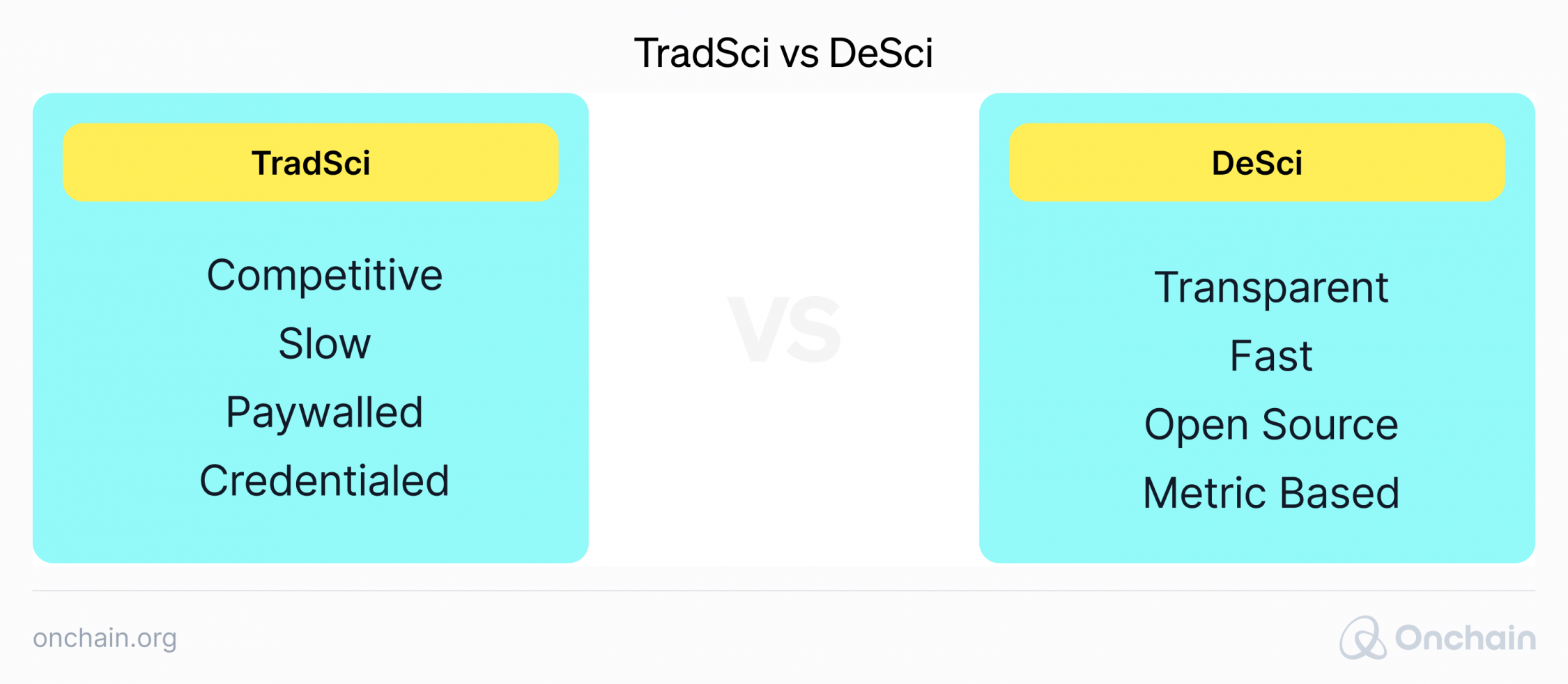
The key components of DeSci include:
- Blockchain-based data storage: Research data is securely stored on distributed ledgers, ensuring immutability and transparency.
Existing use case examples:- Preprints is an open science publishing platform. It uses blockchain to store research papers as NFTs where data remains immutable and transparent.
- DeSci Labs is another publishing platform. It utilizes DLT to store research data in a decentralized manner and guarantee its integrity.
- Decentralized autonomous organizations (DAOs): These govern research projects, allowing for community-driven decision-making.
Existing use case examples:- Galeon is an AI-based decentralized healthcare platform. Its founders created a DAO to enable community-driven decision-making on funding allocation and project direction.
- VitaDAO is a community focused on longevity research. It leverages DAO technology to pool resources and fund research specifically in its chosen niche. It’s worth noting that its DAO has over 4,000 members and has raised $9M in funding to support scientific research.
- Tokenization: Intellectual property and research contributions are tokenized, often in the form of NFTs, enabling fair attribution and potential monetization.
Existing use case example:- Molecule built a Web3 marketplace for research-related intellectual property (IP) tokenized in the form of NFTs.
- Open access: Research findings and data are made freely available, promoting collaboration and reducing barriers to knowledge.
Existing use-case example:- ResearchHub is a blockchain-based publishing platform. It provides open access to research papers on various topics and encourages scientists to collaborate using token incentives.
See an extended comparison of TradSci and DeSci in the table below.
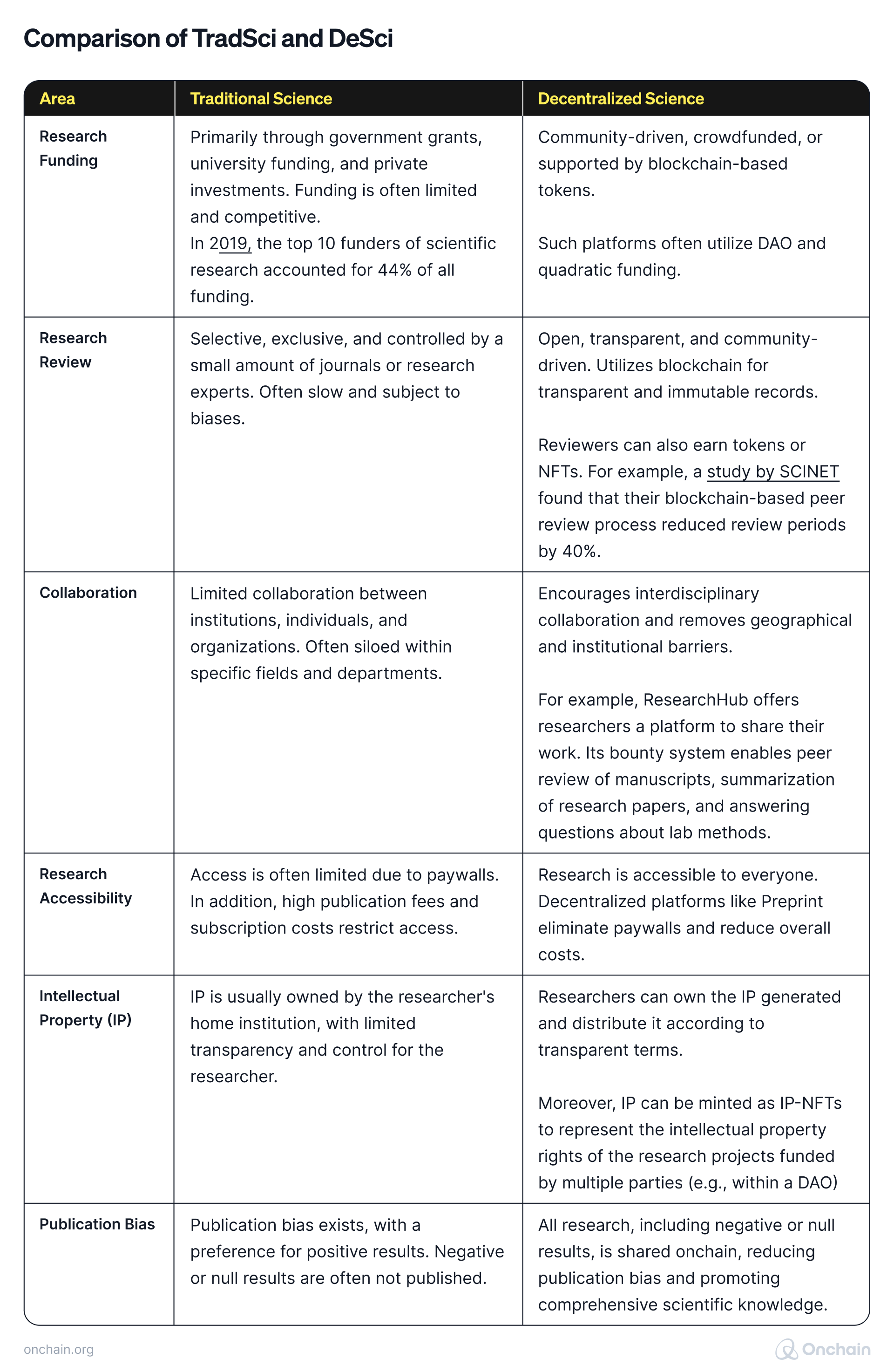
The future of science and research certainly is not black or white. Oliver Slapal, the CTO of Data Lake, believes the real potential is hidden in merging both approaches:

We believe that the ultimate measurement of the success of DeSci is a breakthrough that will make a significant impact on the world as we know it. In order to achieve this, the gap between TradSci and DeSci has to be bridged so that collaboration is frictionless amongst all researchers and problems such as lack of funding are solved. In the ideal future, TradSci should be able to leverage the benefits of DeSci and vice versa.
The DeSci landscape
How are all DeSci components implemented in practice?
The Onchain research team chose 34 projects with working products and an active community out of over 60 analyzed. Our goal was to assess efficiency and impact.
When it comes to DeSci, healthcare is the dominant niche. This industry has already experienced some incremental evolutions driven by decentralized science (more on that in the section on “DeSci beyond academia”).

As you can see, two-thirds of the investigated DeSci projects operate in healthcare, while the remaining third is spread across all other industries.
Healthcare is significantly more heterogeneous. We mapped the most popular subcategories within DeSci for healthcare.
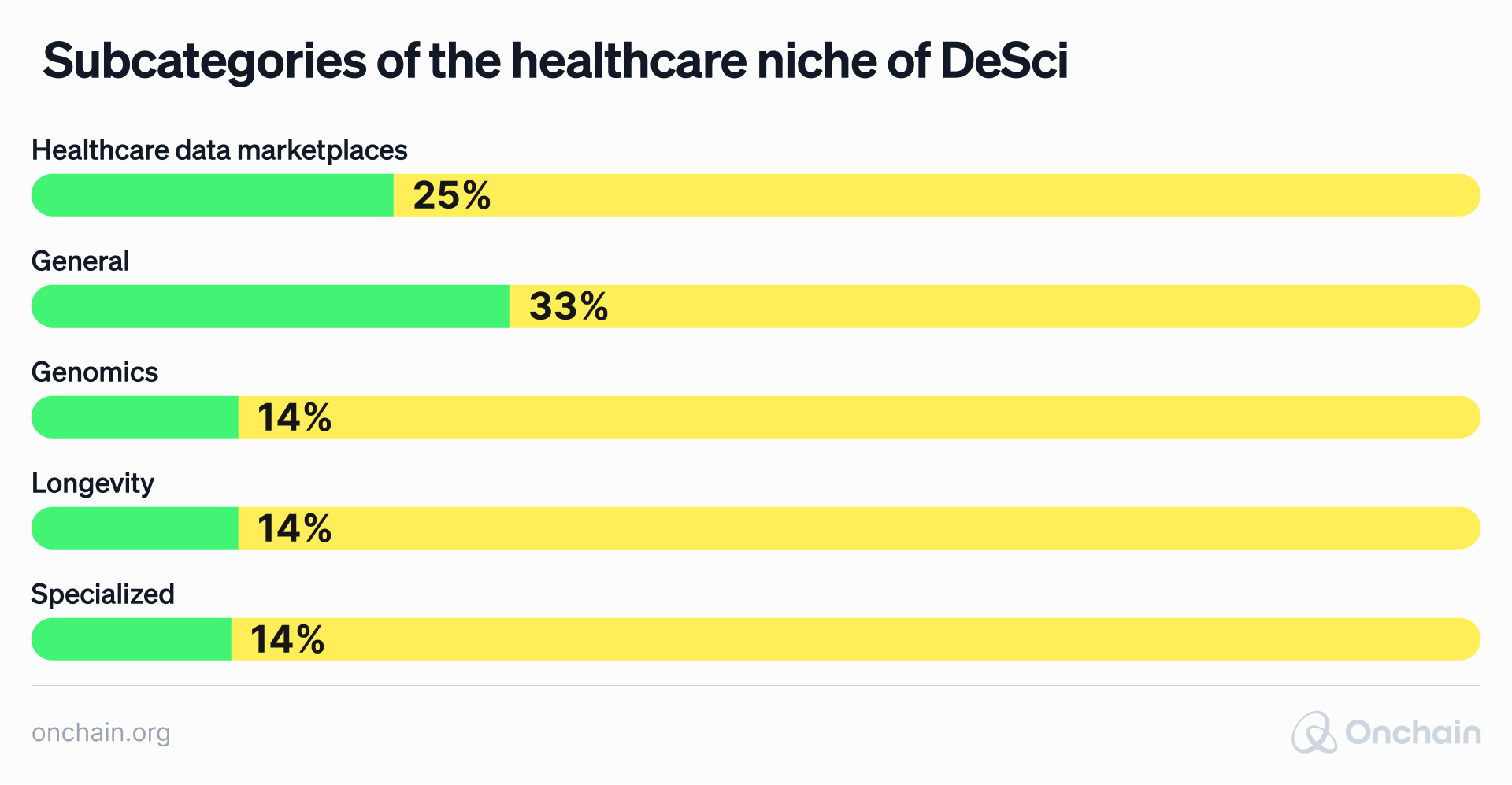
Interestingly, two of the largest healthcare-related project do not specialize in any particular niche. Hippocrat promotes the decentralized use of health data and implements it in hospitals. Galeon focuses on building AI models based on health data.
The most prominent healthcare sub-categories with working products in the market are genomics and longevity. GenomesDAO for example is a patient-owned genomic database that rewards patients with tokens in exchange for sharing data. A similar project is Genobank.io, which builds a marketplace of genomics data. The idea is to generate personalized insights for patients based on the sensitive information they share and store on the blockchain.
Other more specialized projects can provide similar value. HairDAO, for example focuses solely on hair-loss data, and AthenaDAO on women’s health research.
It’s worth noting that many DePIN companies enable and support the purposes of decentralized science by providing decentralized computing power. Good examples to mention here are Dynex, Nuco.cloud, and BOINC.
And last but not least, “open science” is another prolific-looking DeSci approach. It includes publishing platforms that offer open access to research papers and token incentives for their preparation. DAOs and blockchain infrastructure that enable efficient collaboration between researchers and universities is another form of open science.
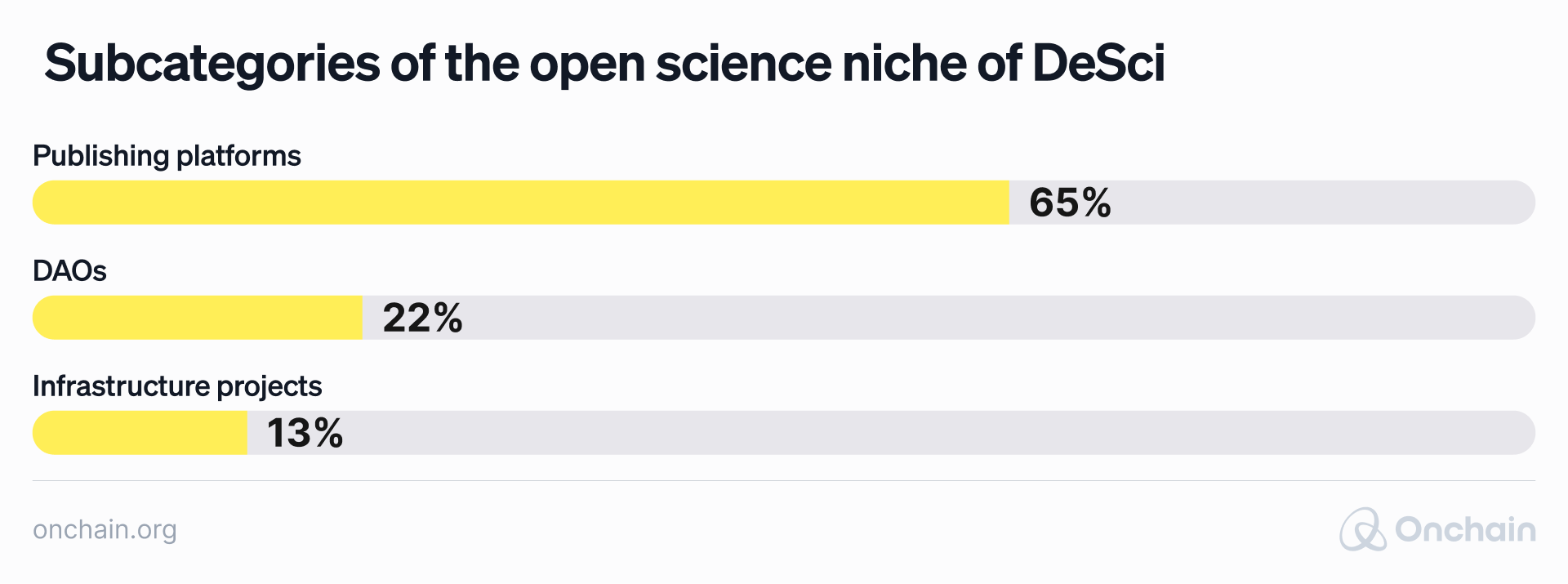
Below is a map of the decentralized science market:
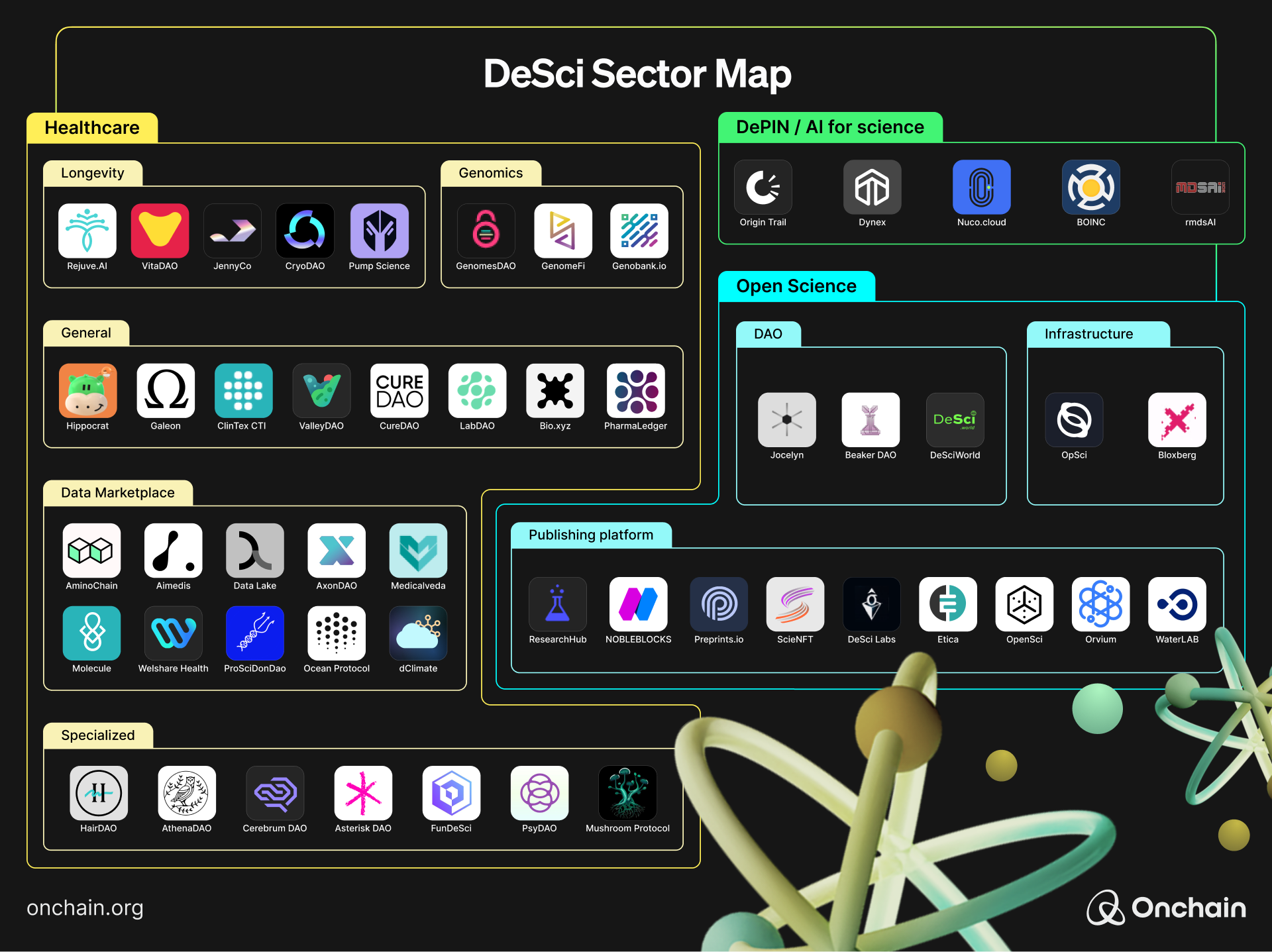

AsteriskDAO: A breakthrough for womxn’s non-reproductive health
Sponsored content by AsteriskDAO
The problem
Traditional clinical research does not draw a distinction between men and women in clinical trials. They are neither required to specify the sex or ethnicity of their subjects nor define the data they have collected by sex or ethnicity. This means that whatever conclusion they have drawn is generalised to the majority of participants (typically white males). It is widely known that men and women are physiologically distinct. However, the data is not representative of this. Similarly, there are differences between ethnicities which are not being acknowledged.
The solution
We at asterisk are working towards a global initiative which provides womxn from every background the means to directly contribute their experiences to research. These disease-specific data lakes will sort data by location, age, menstrual cycle phase, contraception (if any), and more. This will combat the current shortfall found in traditional research methods and provide insight into the effect of menstruation and contraception on female-biased disorders and their treatment.
Our initial project will tackle the lack of female representation in Obsessive Compulsive Disorder (OCD) research. OCD biases toward womxn 2:1 and is an excellent entry point due to the large amount of research and funding already present. Thanks to the wealth of research it is easy to see the gap in OCD research specific to womxn. By identifying these gaps in research we are able to tailor our OCD platform for the development of female-specific data lakes.
We hope to use this initial model to explore other disease states which bias toward womxn and are critically underrepresented in research.
The platform
In the 1970s, women were banned from clinical trials in the United States. Between then and 1993, when US Congress mandated women be included in trials, most of the drugs we utilize today were researched and patented. We are working to address the lack of female-specific data for OCD, including medication side-effects, by building a portal through which participants can enter their symptoms and treatments. We utilized Sepolia and ZK proofs for privacy, Proof of Passport to verify humanity and female-only data, and React to build a comfortable UX for non-Web3 native users. As a result, we are building the first female-specific healthcare data lake.
We deployed on Sepolia for low costs, privacy, and scalability. We use a transaction relayer for the proof submission so that users don’t need to maintain two accts to remain anonymous, which could have put them at a risk of doxxing themselves. On semaphore, our contract limits each individual to submit data reports once per day to restrict point distribution (which will someday convert to tokens). The dAPP is gated by Proof of Passport, which limits acct creation by gender (and only one per person).
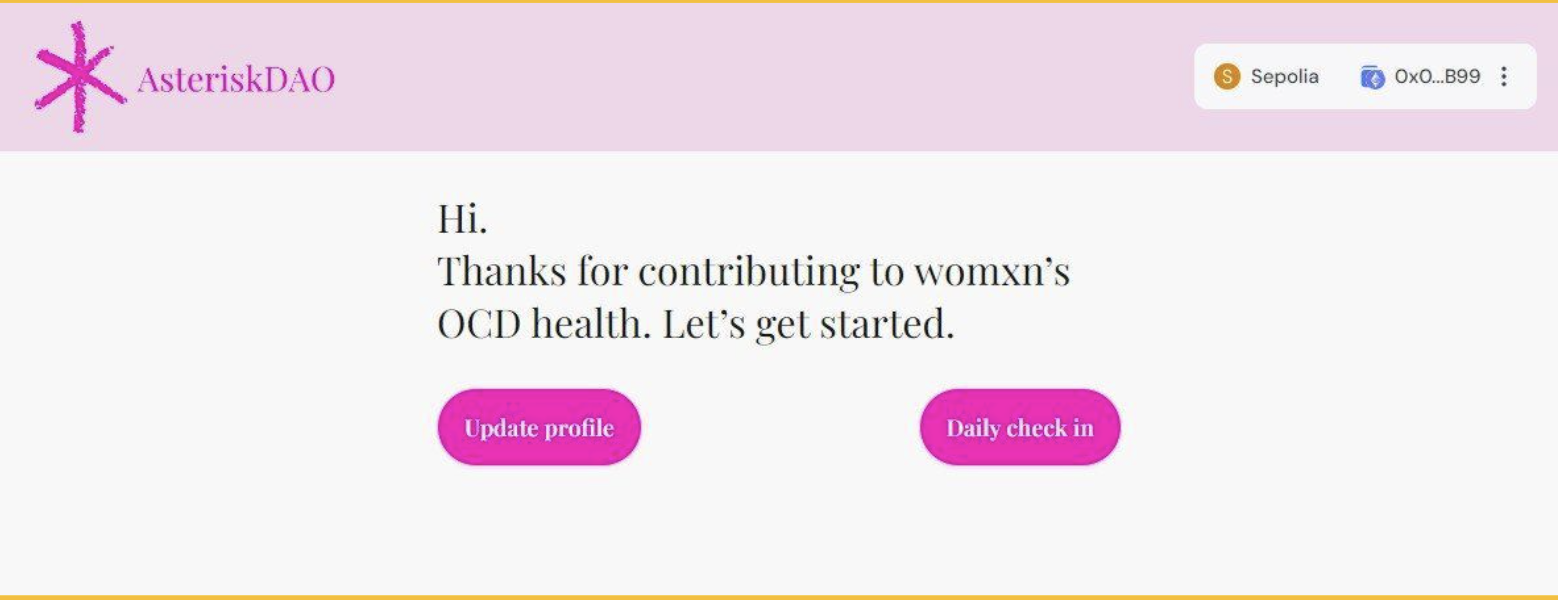
From there the participant is prompted to complete their profile. We ask questions that, based on our market research, will later help researchers filter the data. These include whether a participant is self-diagnosed, where they are located, if they are on any medications (and which), age, ethnicity, and whether they would like to be approached for other studies.
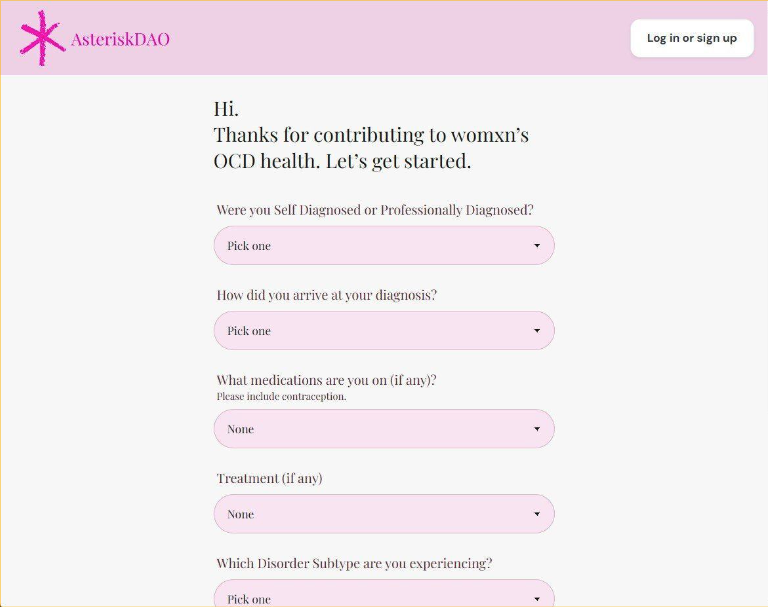
A participant can return to their profile at any time update their diagnosis, medication, and other changeable characteristics.
Finally, the participant is brought to the daily check-in screen for the first time. The daily check-in is designed to feel as simple as a daily menstruation app check-in. The participant will receive reminders to log in and submit their symptoms daily, and receive points for doing so.
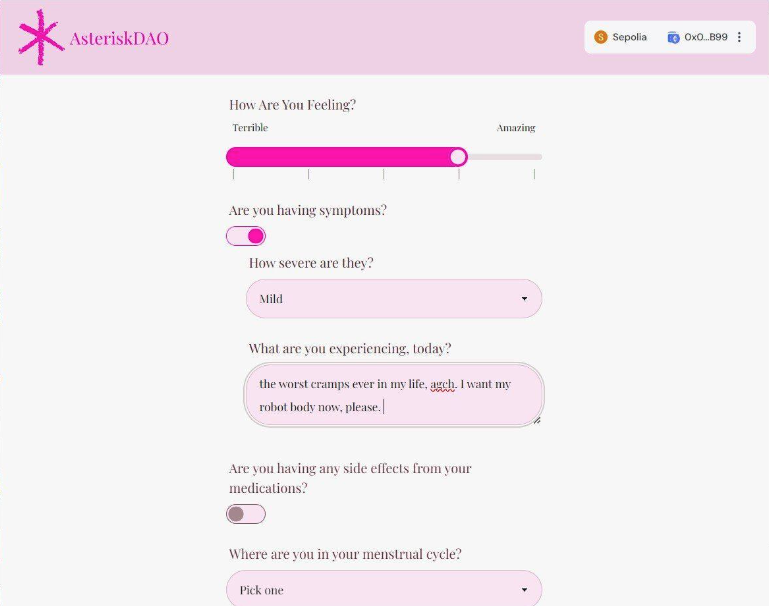
Future outlook
Our next step is to further develop the participant prototype into a workable app for Beta Users. During the participant beta test, we will then develop the backend from which researchers and aligned organizations can sort and access the data.
Now that you have an idea of the types of projects active in DeSci let’s explore their mechanisms. The table below displays an overview of the most frequently utilized approaches.
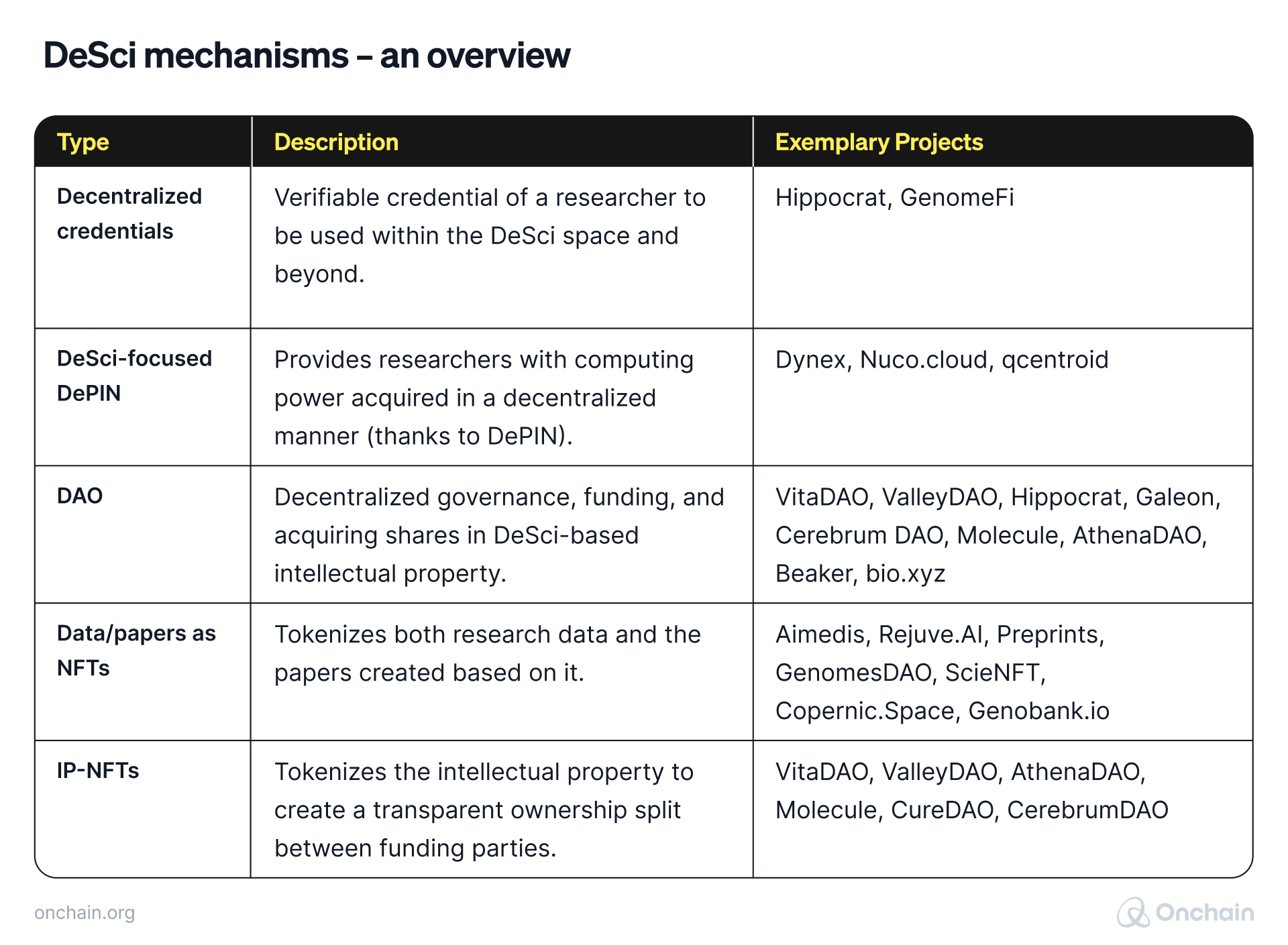
1. Users use the Rejuve.AI app to provide valuable medical data along with their activities in exchange for RJV tokens.
2. This data is transformed into dNFTs (data NFTs), which external parties can use to build apps, research drugs, or create treatment plans. These are then stored on the platform in the form of pNFTs (product NFTs).
3. Whenever a pNFT (e.g., a specific drug) is minted per product ideation, the pNFT shards are distributed to users proportionally based on their contribution to that product, calculated by an AI algorithm.
4. At the same time, RJV tokens earned by an individual user can be used within the platform to buy supplements, medical tests, personalized plans for living longer, and more at deeply discounted prices.
The two most popular mechanisms listed in the table above—DAOs and token incentives—require separate breakdowns. We’ll start with DeSci-oriented Decentralized Autonomous Organizations.
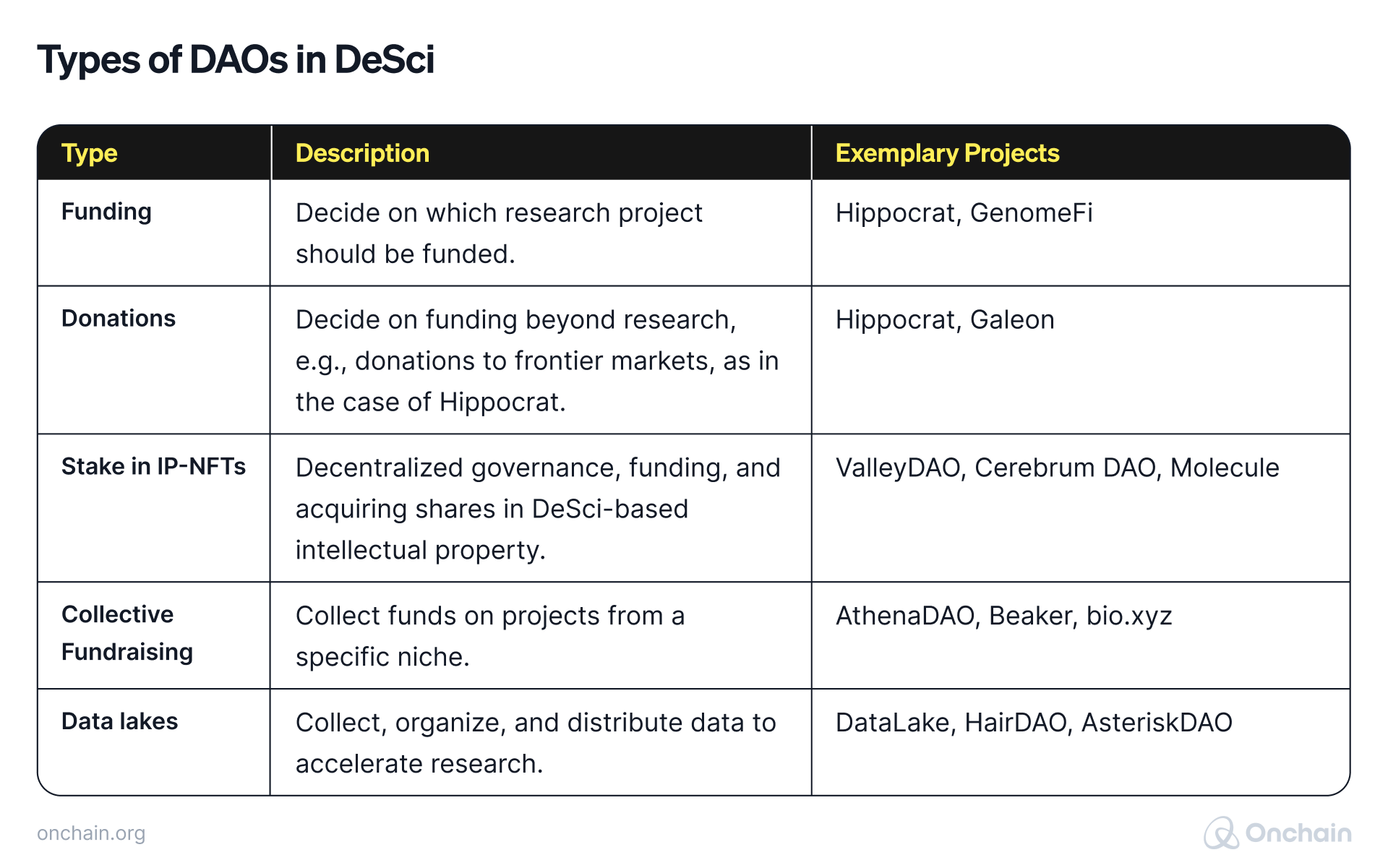
1. Grant funding application from a researcher or a group of researchers.
2. Creation of an IP-NFT from their research project.
3. Licensing the outcome of their work (e.g., new product) to companies.
4. Moving the equity back to the researchers and the Cerebrum DAO – based on their IP-NFT shares.
Another critical ingredient of DeSci companies is their tokenomics. Without incentivizing people to contribute data, share research papers, or govern DAOs, the entire space wouldn’t differ from its centralized counterpart. And as you’ll see in the following table, the utility of DeSci tokens goes way beyond the examples provided.
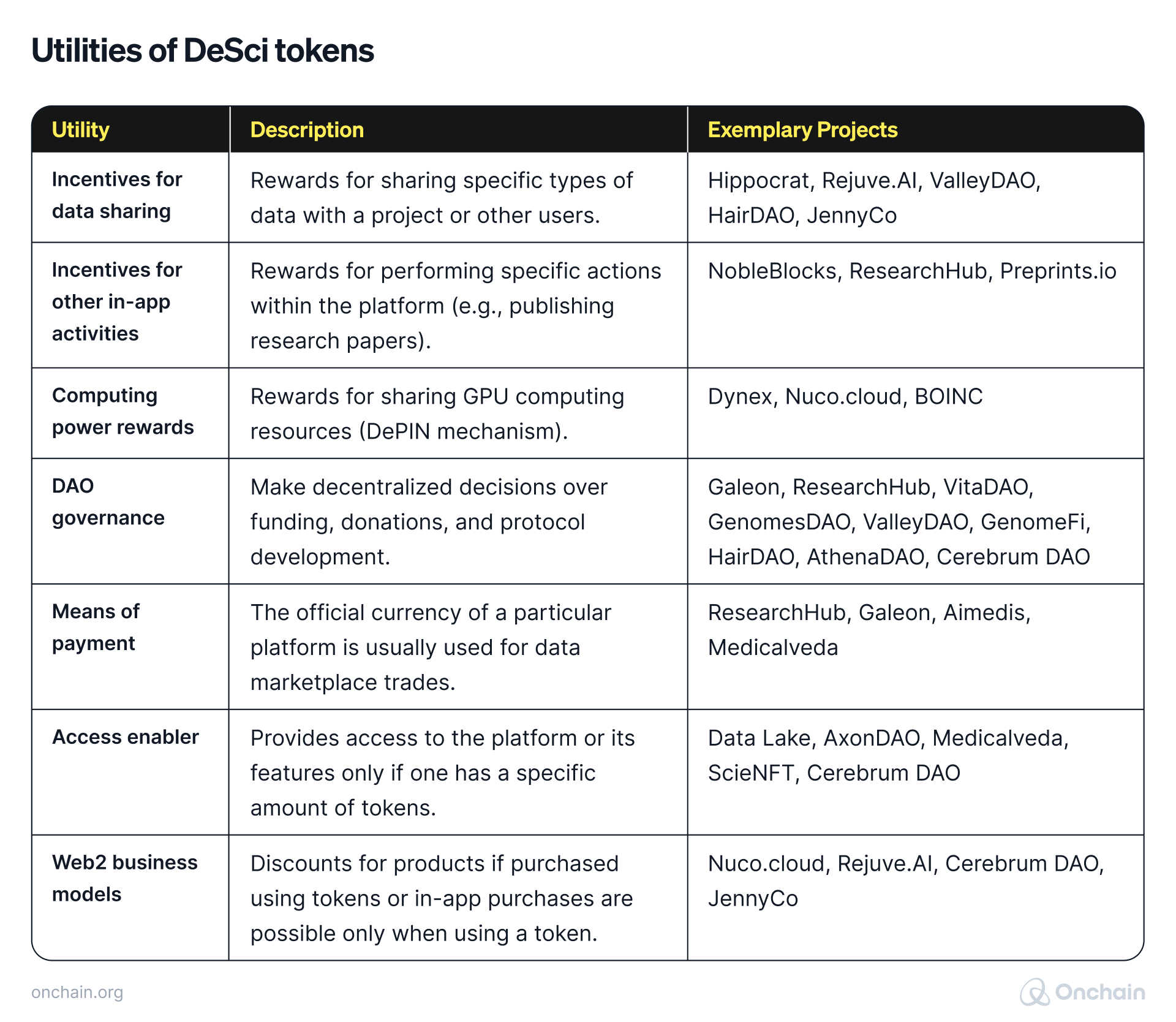
Decentralized science — a reality check
Decentralized science has many promising ideas, but is it too utopic to bring about real change? We analyzed two areas of DeSci to identify mechanisms for implementation and determine if these mechanisms really work.
First, we look at its most anticipated disruption industry: academia. Decentralized technology or token-based incentive adoption in academia provides a strong indicator of DeSci’s future success.
Then, we expand our view of DeSci by assessing its adoption in existing companies. We’ll review the use cases of various projects and gather feedback from the business representatives themselves.
The outcome of this analysis is compiled in the impact assessment below, where we define whether DeSci can make research great again and, if yes, when and where. We conducted our analysis for academic and business purposes.
Decentralized science in academia
DeSci intersects two transformative movements: one in science and the other in Web3 technology.
- In science, there’s a growing push to reshape how research is funded, and knowledge is shared to promote openness and collaboration.
- The core values of Web3 include removing intermediaries and giving individuals more control over their digital assets and interactions.
DeSci combines these ideas, applying Web3 principles to academic research to create a more decentralized, transparent, and equitable ecosystem. This is possible due to three main DeSci attributes: open access, democratized and accessible funding, and fostering collaboration and ownership.
DeSci academic use case 1: Open access
Science should belong to scientists and not the publishers – Alexandra Elbakyan, creator of Sci-Hub.
While science is considered a global public good, much remains locked behind paywalls. High costs make it inaccessible both for researchers and the general public. Submission fees for journals like Elsevier can range from $150 to a staggering $5,000, and subscription fees to read these journals quickly add up.
Purchasing access to published papers can equally balloon. Respondents to our survey confirm that increasing the accessibility of research papers plays a primary role in enhancing their utilization.”
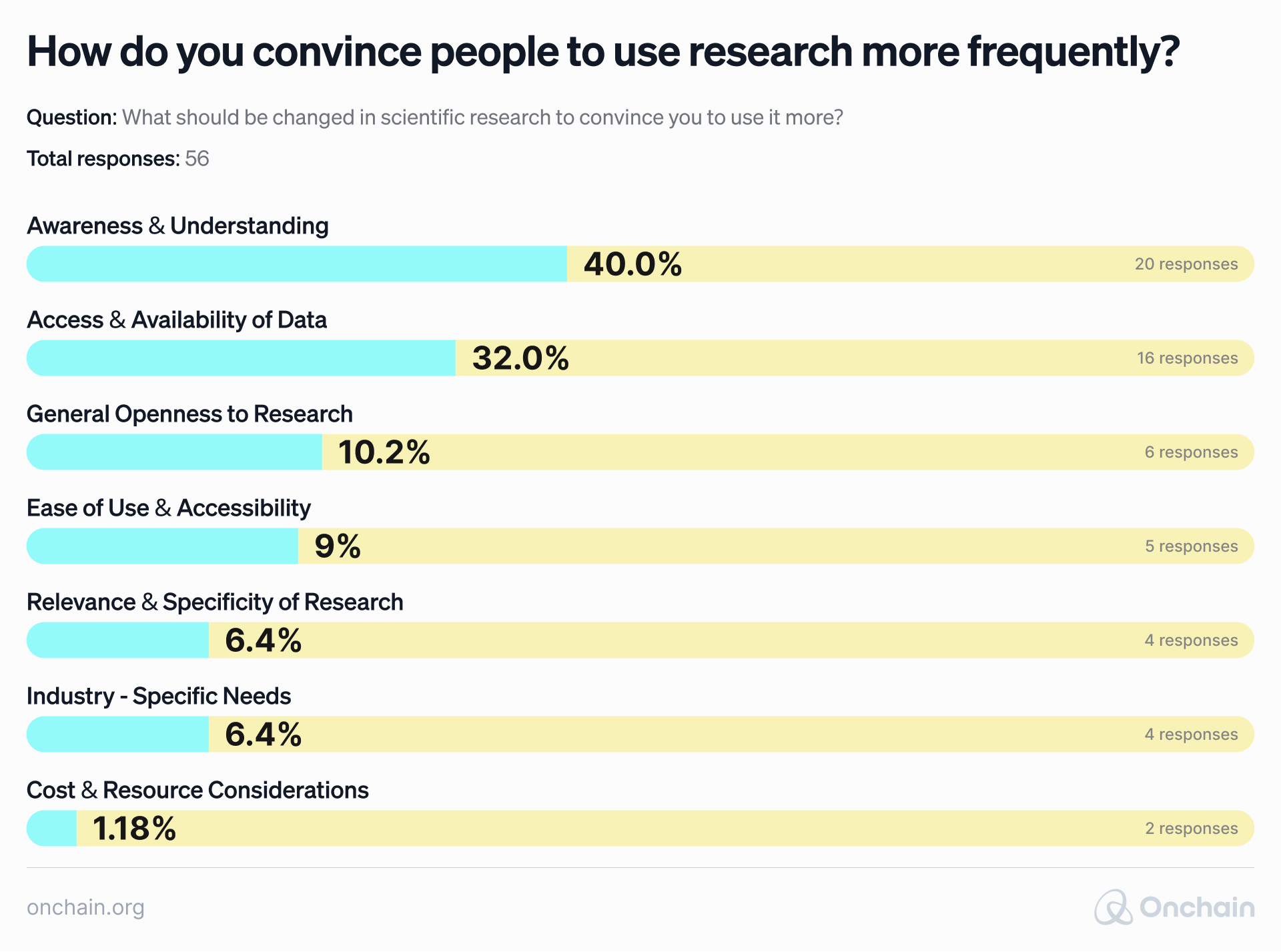
Several non-Web3 platforms, such as ResearchGate or Academia.edu, have been working to address these challenges for years by connecting researchers and facilitating the sharing of publications. While not specifically leveraging blockchain technology, these elements play a crucial role in establishing the foundation for a more open and collaborative research environment.
It begs the question: do we actually need blockchain to create open access to research, or are non-Web3 platforms already doing enough to address these issues?
Let’s make a comparative analysis of ResearchGate/Academia.edu with one of the most promising DeSci projects we encountered during our analysis – ResearchHub.
It is a free and open-source space for researchers to present their work. Researchers can upload both previously published journal articles and original research directly onto the platform. Once uploaded, each publication (whether a research paper or a simple analysis) includes a comment section, fostering discussions and collaboration within the research community.
We’ll take a deeper look at ResearchHub in an upcoming section. For now, look at the side-by-side comparison of Web3 and non-Web3 platform features.
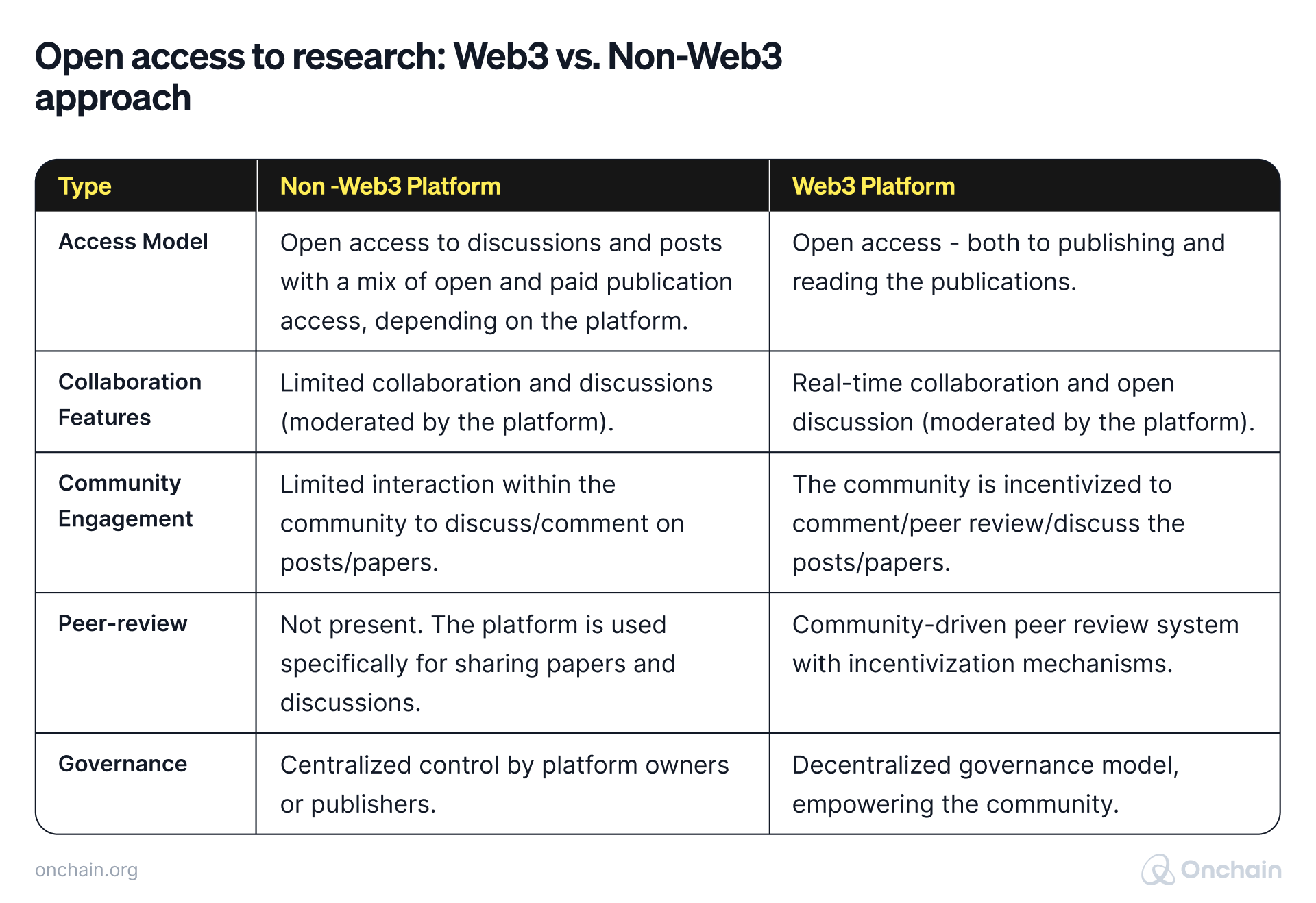
Onchain experiment: How does ResearchHub work?
As we’ve established the need for publishing platforms to implement DeSci principles effectively, we’ll now investigate how well these platforms live up to expectations. As a test object, we chose the top contender in this category: ResearchHub. We’ll assess how closely it aligns with core DeSci principles and determine its potential to remodel and revive research – especially for academic purposes.
This analysis is based on examining the most critical elements of ResearchHub’s value proposition via their whitepaper and communications.
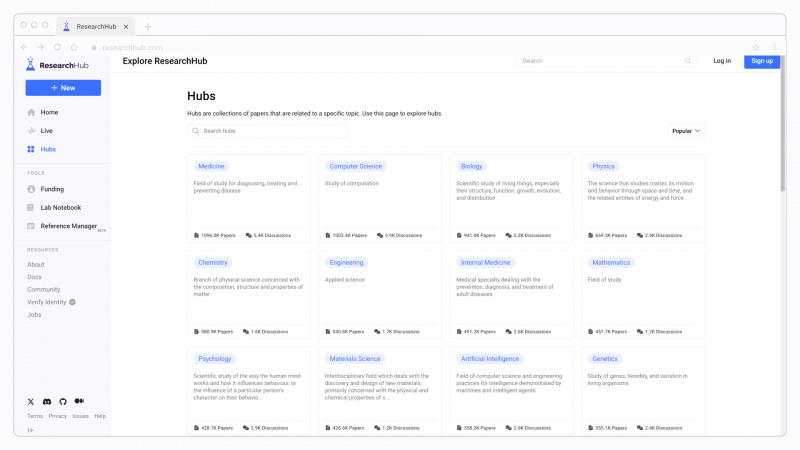
1. Challenging the traditional academic publishing model with open-access hubs.
Traditionally, academic publishing has been dominated by a few large publishing houses like Springer, Elsevier, and Wiley, each owning thousands of journals. This model has limited the accessibility and diversity of research.
ResearchHub uses “Hubs,” topic-specific forums, which provide a refreshing new take on traditional issue-bound journals. This simplified approach creates a space where researchers can easily share their work and have open discussions. The Hubs definitely feel more collaborative and less restrictive as compared to the traditional publishing cycle.

I believe that DeSci's innovative approach to incentivizing research not only overcomes traditional limitations but also cultivates a more responsive and impactful scientific ecosystem, making it essential in a rapidly evolving world with high demand for cutting-edge research.
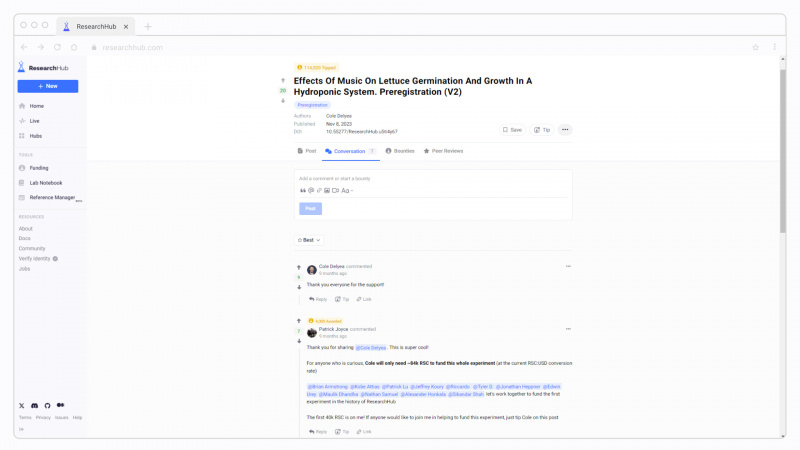
2.Community-based transparent funding.
On ResearchHub, users can raise funds for their studies through “preregistration,” where research plans can be publicly shared before conducting any experiments. This allows the community to engage with and support interesting projects.
For example, one paper on ResearchHub attracted 114,020 RSC (approx. $18,492.04 as of 18 July 2024) in funding across two preregistrations. The research explores whether different types of music affect the growth rate of lettuce.
However, it’s important to note that a significant amount of this funding came directly from ResearchHub (their co-founder donated approximately 40,000 RSC).
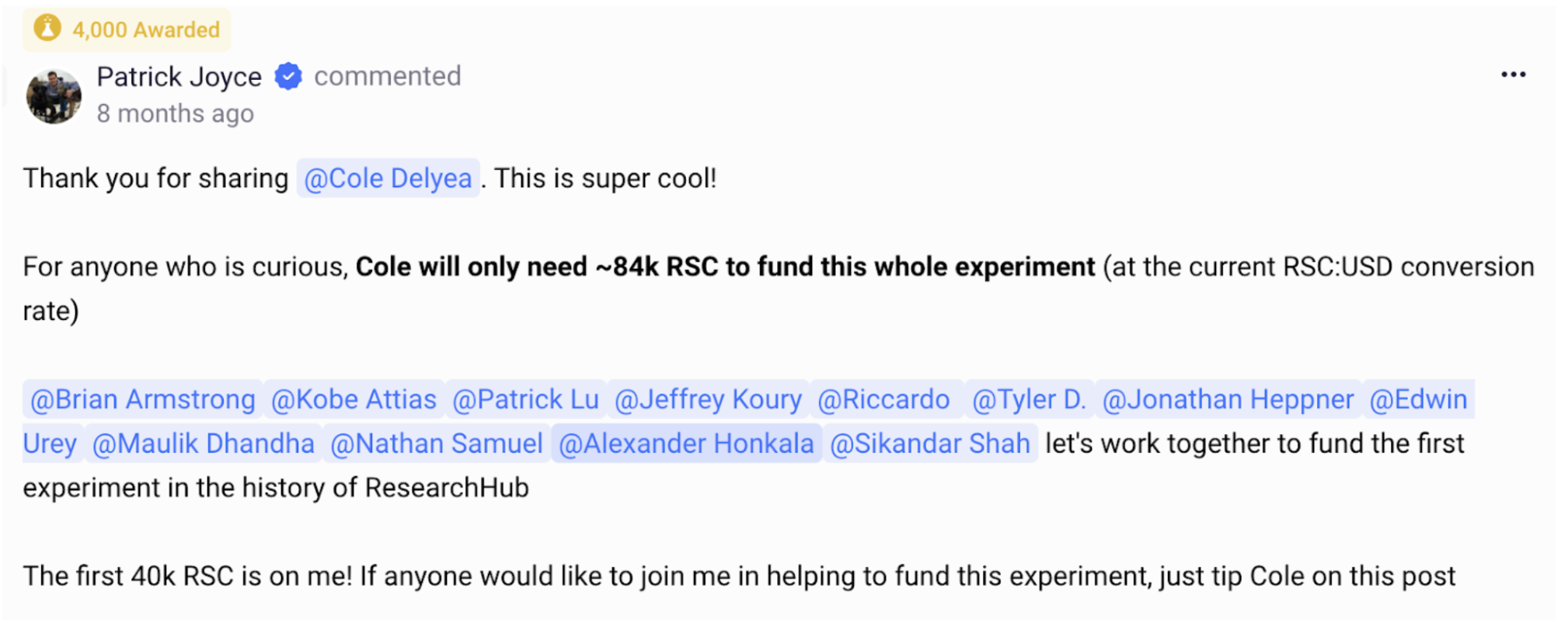 Source: https://www.researchhub.com/post/1156/effects-of-music-on-lettuce-germination-and-growth-in-a-hydroponic-system-preregistration-v2/conversation
Source: https://www.researchhub.com/post/1156/effects-of-music-on-lettuce-germination-and-growth-in-a-hydroponic-system-preregistration-v2/conversation
3.An incentivized peer-review system.
ResearchHub’s unique peer-review mechanism’s open approach caught our attention. As researchers, we appreciate the opportunity to engage in discussion and share diverse perspectives within a community. Their bounty system is also intriguing, which could incentivize more reviewers to participate.
However, we have some reservations about the quality of the reviews. Since anyone can participate, regardless of their expertise, there’s a risk of receiving less rigorous or informed feedback compared to traditional peer reviews.
Another concern is the need for formal recognition of ResearchHub reviews. In the current academic landscape, such reviews carry a different weight than traditional peer-reviewed publications, which could discourage established researchers from actively participating. Despite having significant potential, ResearchHub’s peer-review system needs further refinement to ensure quality control and objectivity.
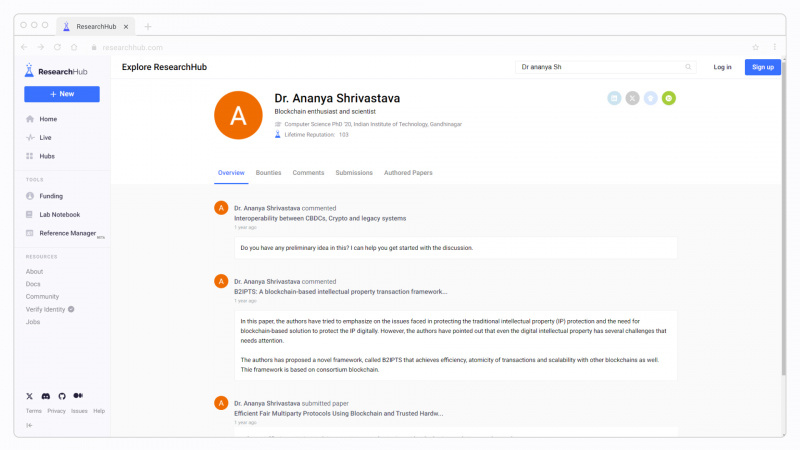
4. A reputation system.
ResearchHub’s reputation system is a central feature of the platform, designed to encourage high-quality contributions and build a vibrant community.
In theory, it’s a great idea – researchers earn “REP” points for activities like upvoting, commenting, reviewing, and completing bounties. The idea is that upvotes from reputable users hold more weight, promoting quality content.
As illustrated in the image below, users can accumulate rewards through various activities on the platform over time.
In practice, however, we’ve noticed some potential issues. Users may aim to accumulate REP rather than create truly valuable content. This could lead to a system where “quantity overshadows quality.” Additionally, this system may unintentionally favor established researchers with more extensive networks, who naturally receive more upvotes, overshadowing emerging researchers.
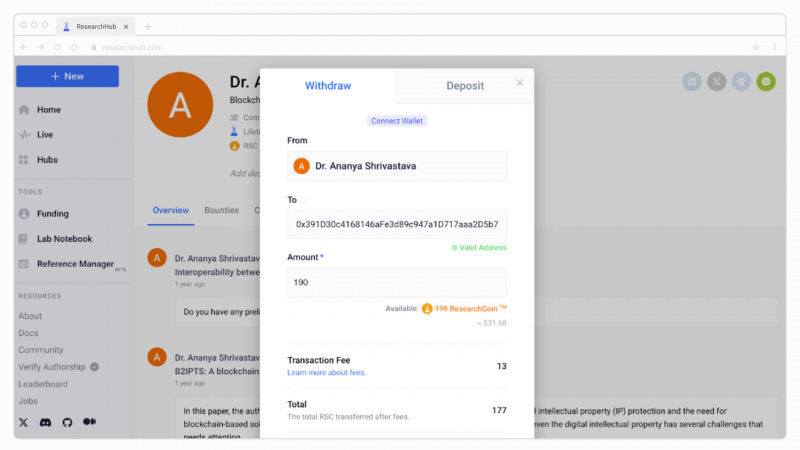
5. Redeeming incentives for “real-world” money.
ResearchHub’s point system and the potential to earn real-world rewards are quite attractive for researchers.
The prospect of redeeming RSC tokens is the same. However, we’ve experienced a significant hurdle: high transaction fees associated with redeeming these points due to the platform’s reliance on the Ethereum network. The value of the earned RSC diminishes significantly when faced with Ethereum’s gas fees. Unfortunately, this has discouraged us (and likely other users) from actively using the platform.
Based on the findings from our “The Future Is Modular” report, we encourage developers of such DeSci platforms to migrate to layer-2 solutions like Lisk, which could substantially reduce transaction costs. This would not only enhance the real-world value of the points but also increase incentives for researchers to engage more actively with the platform.
Conclusion
ResearchHub presents a promising alternative to traditional academic publishing with its open-access model, community-driven approach, and unique features like bounties and a reputation system. The platform’s innovative community funding model, demonstrated by the lettuce study, showcases the potential of decentralized science to support diverse research.
While its simple login process and “Hubs” facilitate easy sharing and discussion of research, the platform’s peer-review process and reputation system require further development to ensure quality and fairness.
ResearchHub alternatives
ResearchHub provides scientists with a robust entry point into Web3-based research and collaboration, but it’s not the only platform for developing such solutions. Let’s compare it with some notable alternatives to review their strengths and weaknesses.
- Preprints is a platform that leverages blockchain technology to encourage collaboration between researchers in conducting, funding, publishing, and applying research. It records manuscripts as NFTs powered by Ocean Protocol to ensure their permanence and accessibility.
- ScieNFT uses NFTs to change how scientific papers are shared and owned. It enables researchers to mint their publications, datasets, and other research outputs as unique digital assets, which can then be bought, sold, and collected on the ScieNFT marketplace.
- NobleBlocks introduces a decentralized marketplace model where researchers can propose projects, secure funding through community-driven decisions, and collaborate on research initiatives.
Below, you’ll find a comprehensive comparison between all 4 approaches. Note that most of the platforms are still under active development, as highlighted in yellow in the table below:
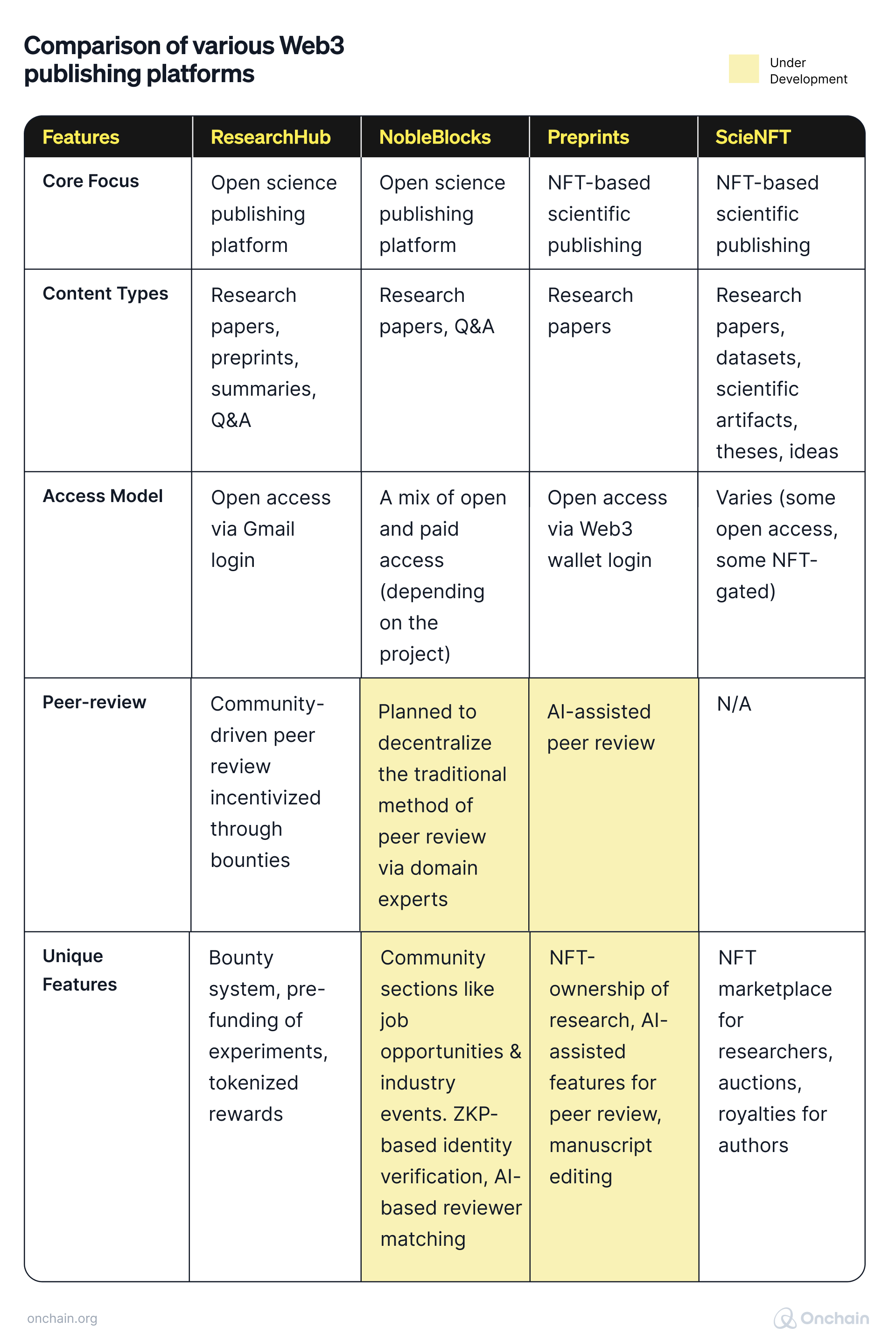
Which DeSci publishing platform is currently the most promising? ResearchHub stands out for its robust community features, including Hubs, bounties, and a reputation system. All of these actively encourage collaboration and knowledge sharing among researchers. Additionally, its bounty system incentivizes participation in peer review, a crucial aspect often overlooked by traditional publishing models.
NobleBlocks, while still in development, shows significant potential. Its unique features, such as ZKP-based identity verification and AI-assisted peer review, could address key research collaboration and peer review challenges. In addition, its primary goal is to streamline and enhance the traditional peer-review process, a critical component of scientific research validation.
While Preprints and ScieNFT contribute to open access and explore new ownership models through NFTs, their lack of robust community engagement features hinders their potential for driving DeSci adoption. However, it’s important to note that these two platforms are currently in earlier stages of development.
DeSci academic use case 2: Democratized and accessible funding
Every hour a scientist spends trying to raise funds is an hour lost from important thought and research – Issac Asimov, American writer and Professor at Boston University.
Let’s return to the issue of securing funding for researchers. Blockchain technology, at least in theory, may provide a disruptive solution. Web3 fundraising options like token sales, NFTs, and decentralized finance (DeFi) tools can offer scientists more diverse and sustainable funding sources.

Initially skeptical about Decentralized Science (DeSci), I began to see its potential. DeSci's unified, transparent ecosystem resonated with me, especially the prospect of individuals directly funding research in areas that matter. This democratization could accelerate breakthroughs in critical fields.
For example, Molecule, a decentralized biotech protocol, connects academics and biotech companies with streamlined funding options. The platform enables researchers and investors to govern and own research-related intellectual property (IP) directly. Molecule now has over 250 research projects listed.

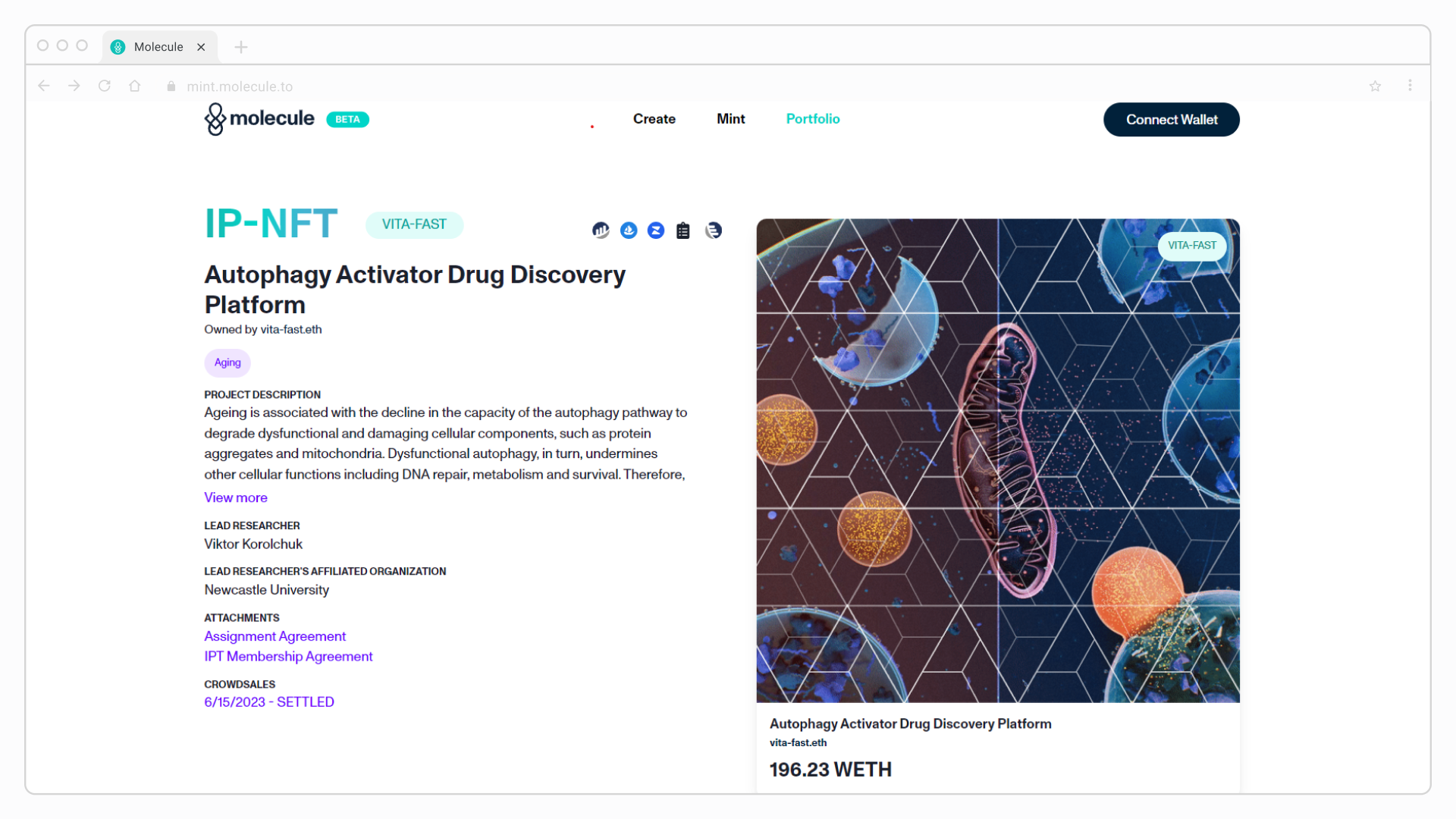
Source: https://mint.molecule.to/ipnft/2
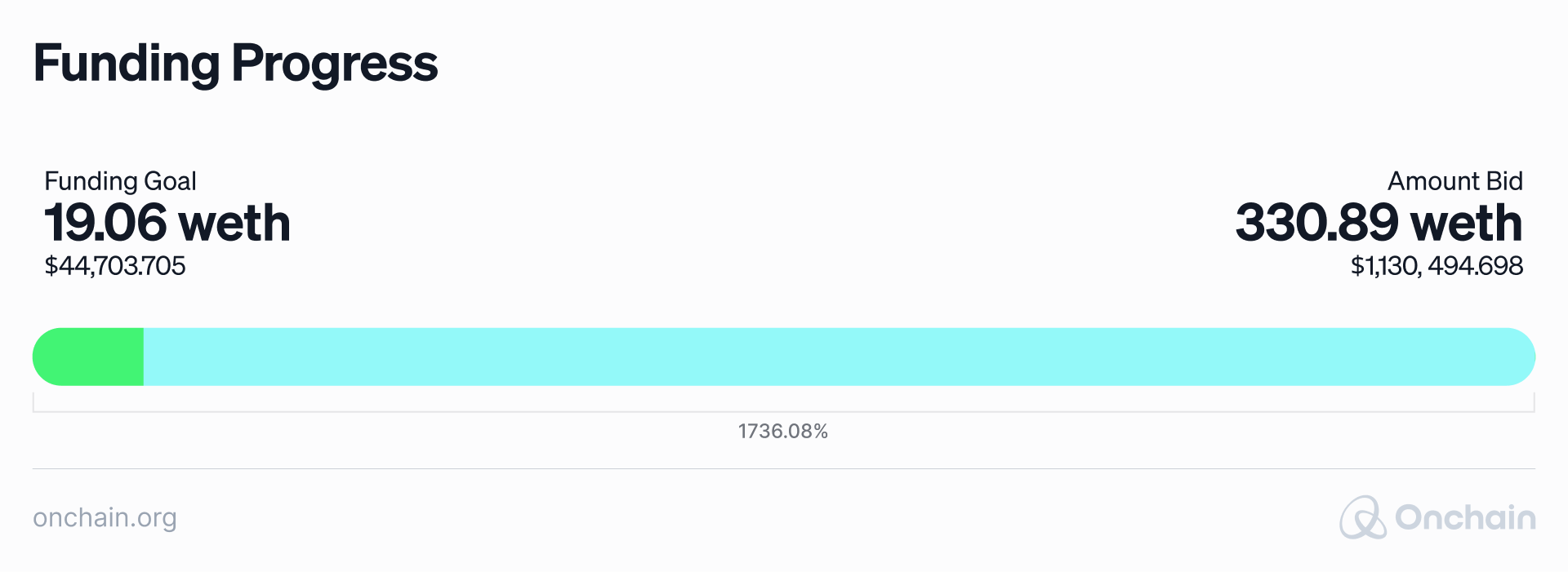
Source: https://mint.molecule.to/ipnft/2/crowdsale/41142438389681449217472172510084102334711824900028918260820949119924249271745
Beyond research funding, DeSci projects also support the development of biotech leaders by facilitating their transition from academia to entrepreneurship. For instance, Nucleate’s Activator program provides mentorship, expert workshops, and industry connections to help scientists transform their research into scalable startups.
Eventually, the leaders in the DeSci world will become the evangelists for the entire movement. As stated by Veronica Kirin, Founder of AsteriskDAO, a platform for women’s non-reproductive health resources and data:

DeSci will be a critical component of science in general. My personal hope is that it reaches ubiquity – as it provides compelling solutions to centuries-old problems.
While the healthcare field has seen growing support from various companies, other engineering disciplines, such as computer science and electrical engineering, have yet to experience the same level of attention and investment.
Fortunately, platforms like BOINC (Berkeley Open Infrastructure for Network Computing) can bridge this gap. BOINC is a distributed computing system developed at the University of California, Berkeley. It allows individuals to contribute their unused computer processing power to various scientific research projects. In return, individuals can earn Gridcoin tokens. It again demonstrates the potential power and usefulness of DePIN & DeSci working in tandem.
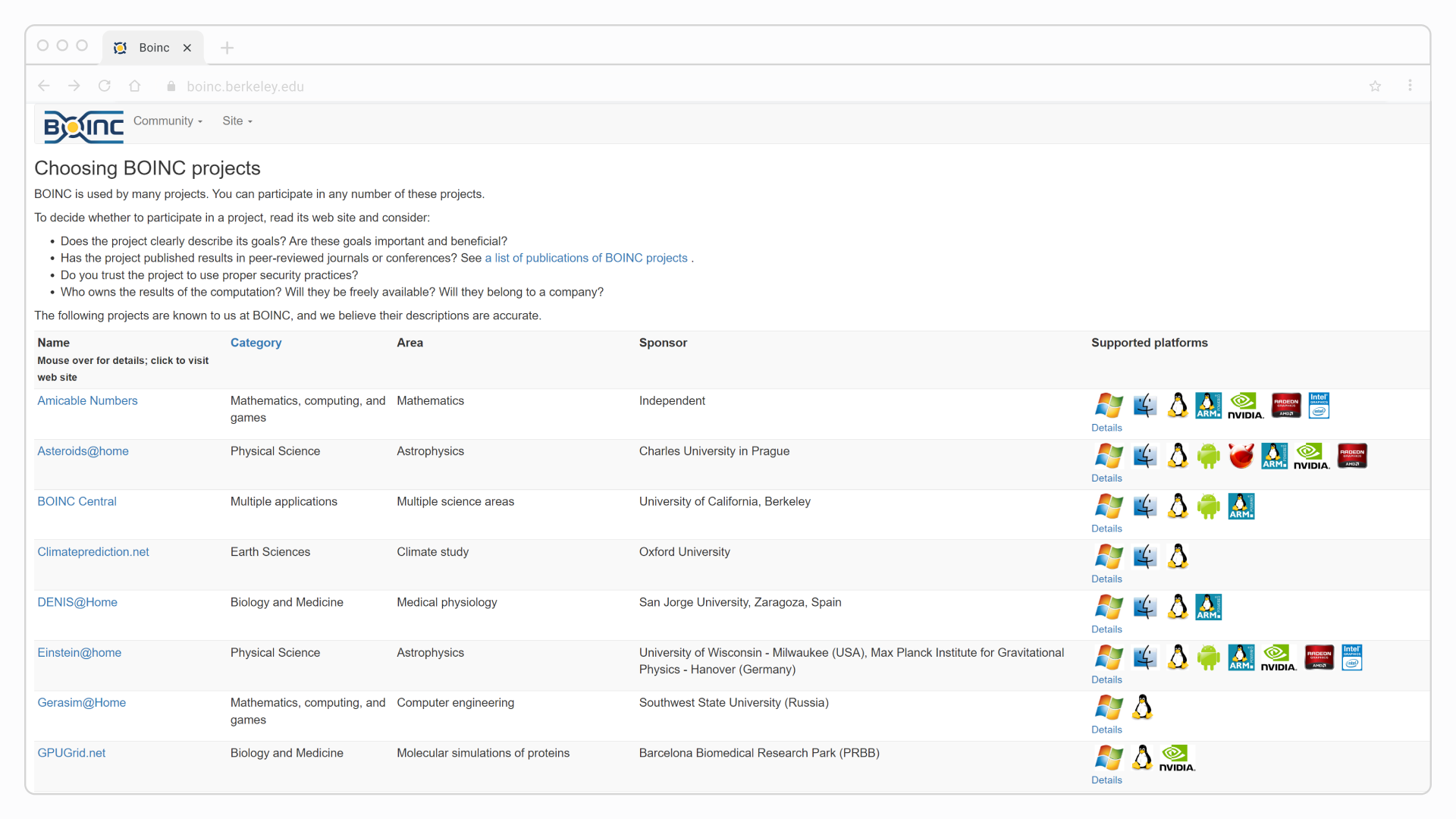
Source: https://boinc.berkeley.edu/projects.php
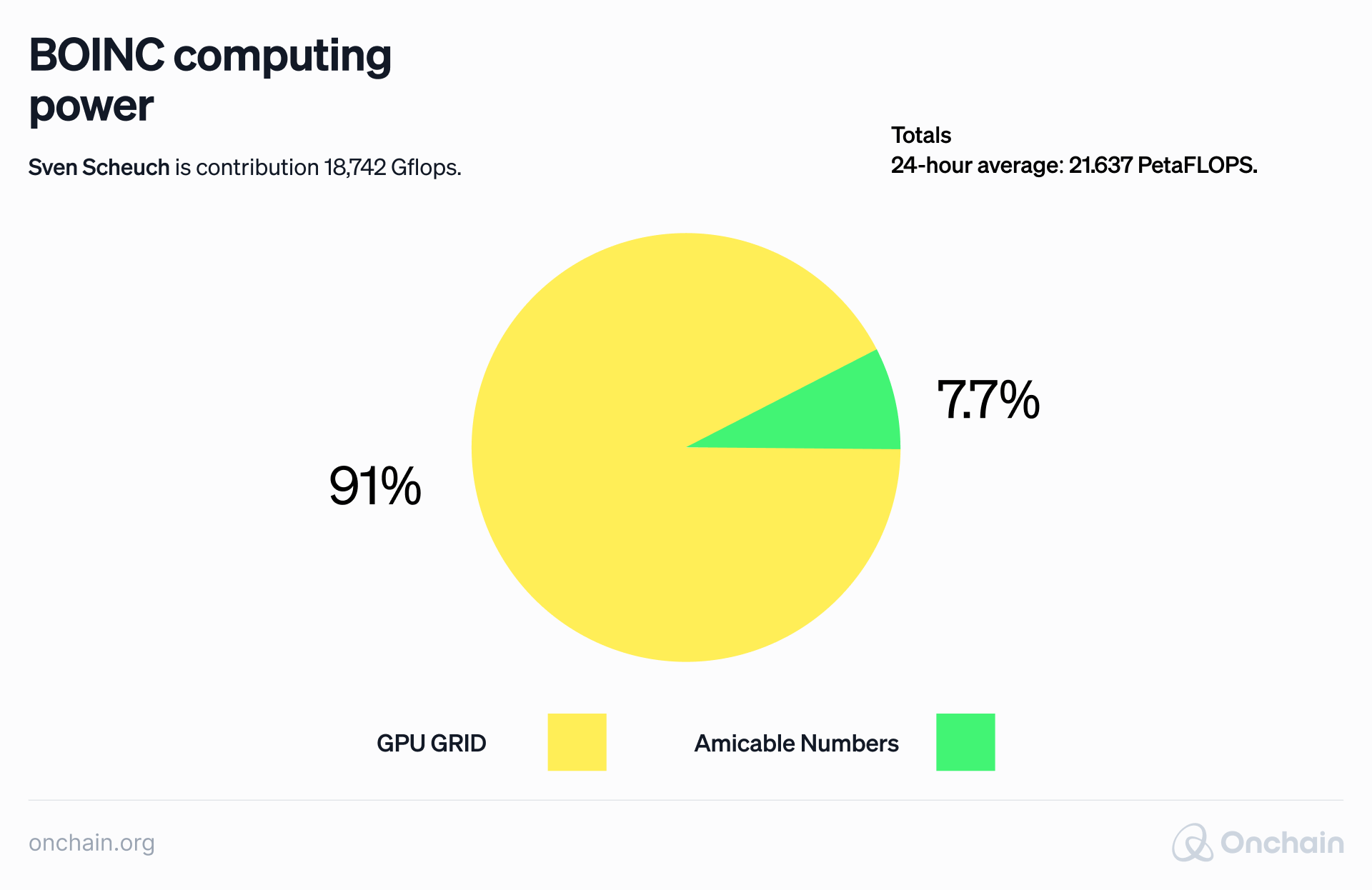
Source: https://boinc.berkeley.edu/projects.php
DeSci academic use case 3: Fostering collaboration and ownership
We are all now connected by the internet, like neurons in a giant brain. – Stephen Hawking
Effective collaboration is crucial for driving innovation and knowledge advancement in academia. However, traditional academic structures often present challenges to seamless cooperation between institutions and researchers.

As a researcher, the desire for increased collaboration and feedback has always been crucial to improving the quality of my work. DeSci has emerged as a solution to this long-standing obstacle, and I believe it holds immense potential to benefit countless other researchers in academia.
For example, DeSci nodes, a publishing platform developed by DeSci Labs, plays a crucial role in fostering collaboration and data sharing within the decentralized science ecosystem. It transforms how researchers can publish and share their research by integrating manuscripts, data, code, and more into versionable research objects. The platform also provides tools for researchers to easily share their research objects with collaborators, invite feedback, and track contributions.
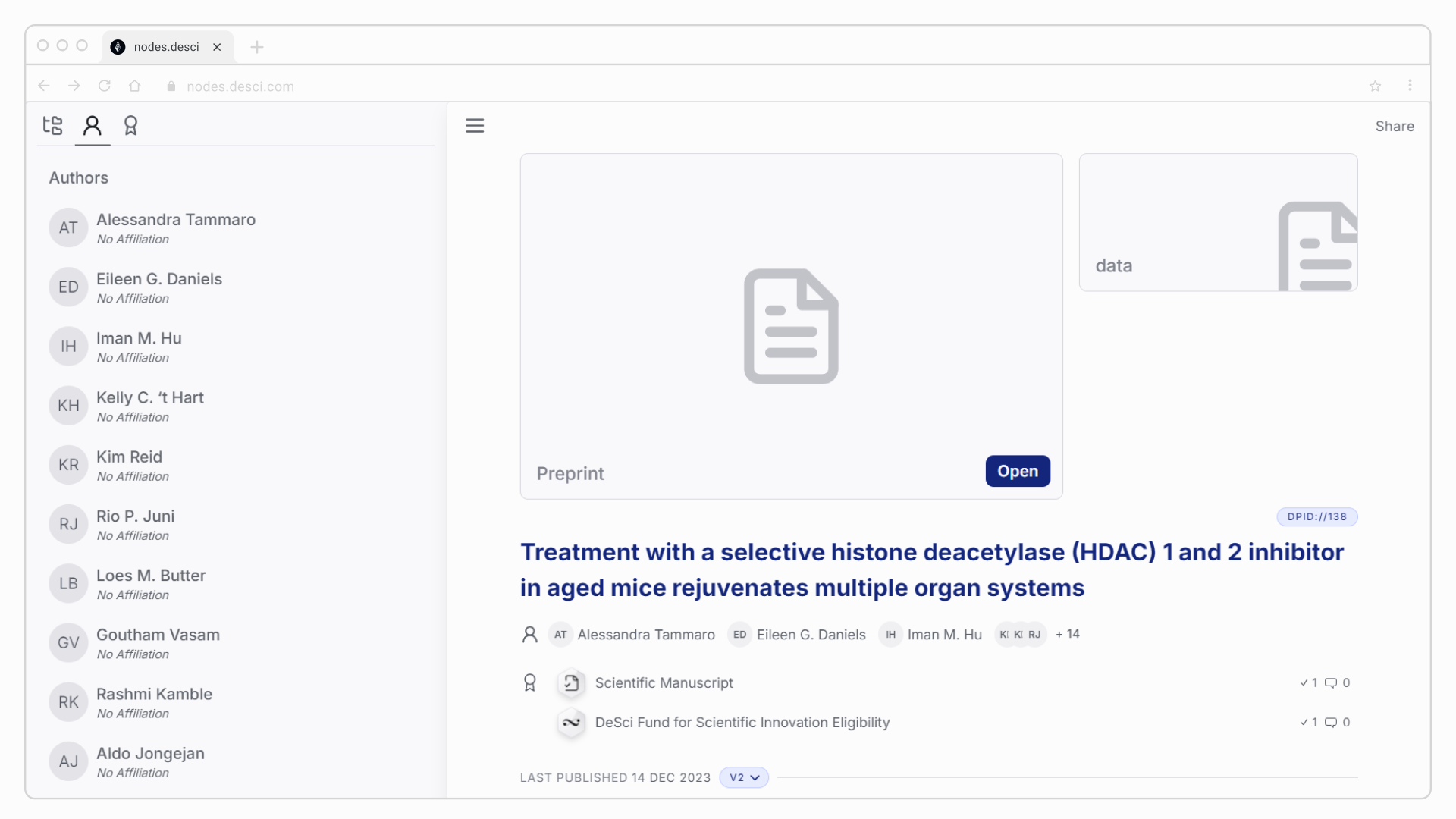
Source: https://nodes.desci.com/dpid/138
Also, more general Web3 projects like Ocean Protocol, which we covered quite extensively in our recent AI and Blockchain report, are tackling the issue of data siloing. To address this issue, Ocean Protocol creates decentralized marketplaces where researchers can access and share data securely. This enables them to access diverse datasets and collaborate on data analysis projects without transferring large amounts of data between institutions.
Decentralized identifiers (DIDs) also play a crucial role in enhancing trust and data ownership in this collaborative environment. Preprints, for example, link DIDs to data NFTs, allowing researchers to share securely and even monetize their data while retaining control. Moreover, NobleBlocks is exploring ZKP-based DIDs to enhance privacy and security further in research collaboration.
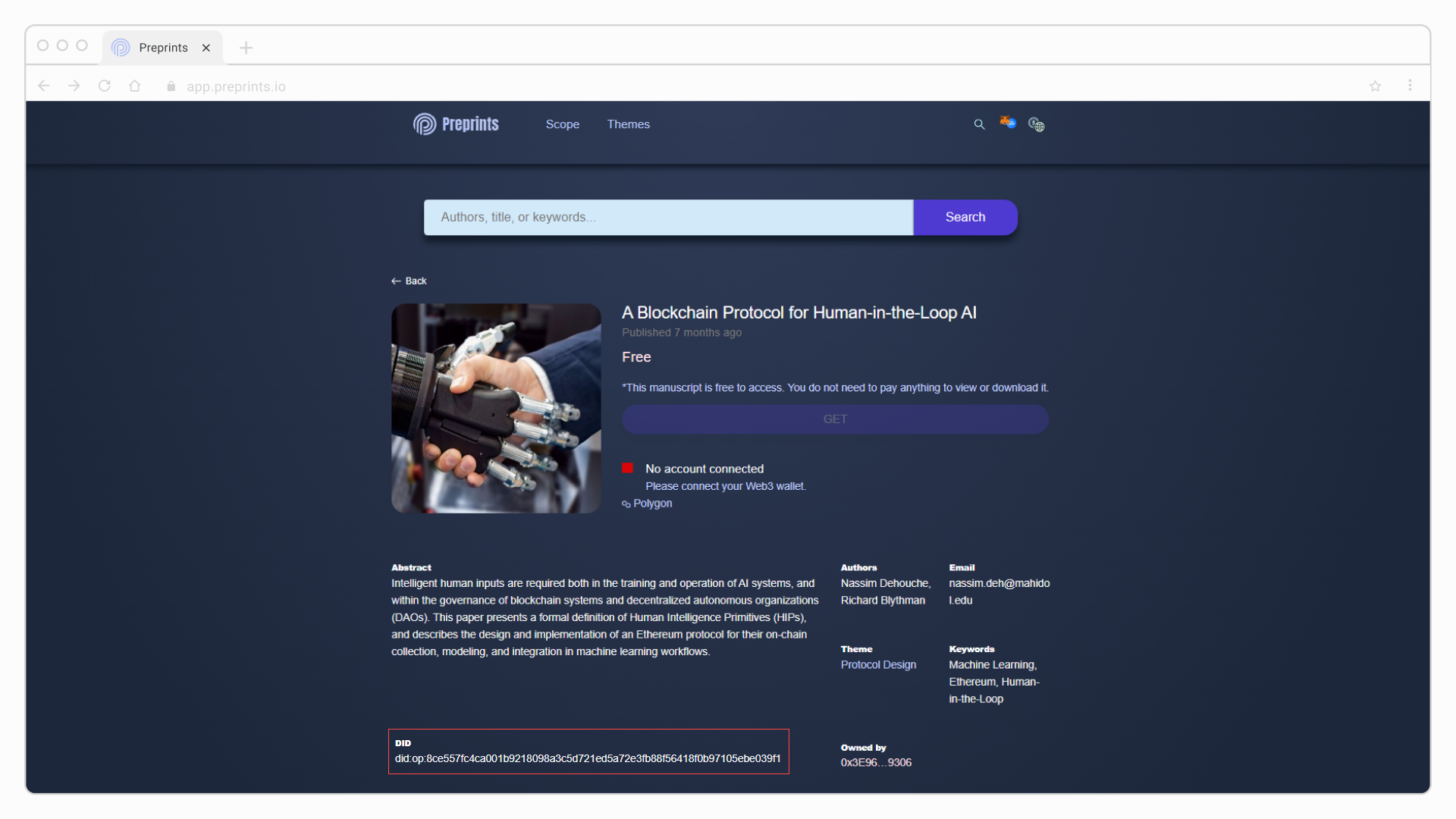
Source: https://app.preprints.io/asset/did:op:8ce557fc4ca001b9218098a3c5d721ed5a72e3fb88f56418f0b97105ebe039f1
The need for collaboration became evident in our survey for this report. When asked how to tackle challenges related to scientific research, respondents frequently mentioned combining technology with collaboration, which underscores the entire concept of DeSci.
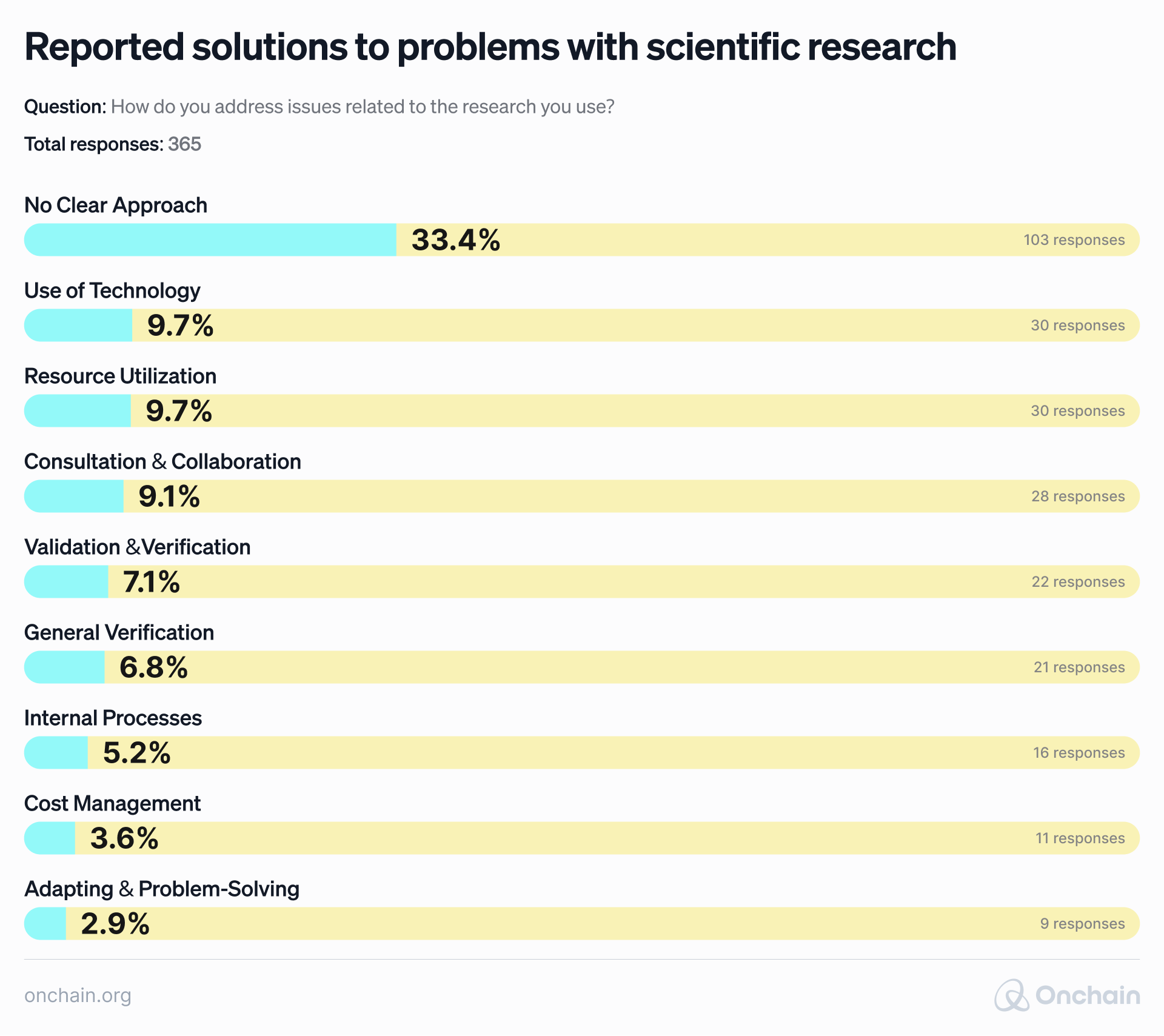
Moreover, DeSci-based collaboration isn’t limited to alliances between individual researchers. Over 50 leading universities and research institutions worldwide have joined forces to form the Bloxberg consortium. This collaboration strives to develop and utilize blockchain technology for various academic purposes. Among the application areas are issues such as verifying credentials, securing research data, and ensuring the integrity of publications.
Bloxberg serves as the best example of DeSci’s traction in academic institutions. Numerous applications developed by consortium members, scientists, and other collaborators leverage “the blockchain for science” to enhance the scientific ecosystem. You can find a few of the most promising examples below:
- INPTDAT is a platform designed to make research data and information from various fields related to plasma physics and medicine easily accessible. It aims to help researchers find, access, share, and reuse data within the low-temperature plasma physics community.
- Creator: Hamburg University of Applied Sciences
- Status: Working
- BISE Student offers an open-access platform on which students can easily publish their Bachelor's, Master's, and Diploma theses.
- Creator: Karlsruhe Institute of Technology
- Status: Working
- A blockchain-based platform that enables researchers, publishers, and others in the scientific community to seamlessly integrate and access peer review information through a decentralized system.
- Creator: Max Planck Society
- Status: Pilot
It’s worth noting that despite having shown great promise in specific scientific domains (such as healthcare), DeSci’s reach remains limited. Engineering disciplines such as computer science, electrical engineering, mathematics, and physics have yet to experience the same level of disruption and innovation.
We explore this in the next section, looking at the DeSci x business tandem.
DeSci beyond academia
The DeSci ecosystem has already given rise to various technological concepts and real-world implementations across industries. In the following sections, we’ll explore key DeSci platform business models, evaluating their impact, efficiency, trust, and scalability. We’ll examine concrete examples of DeSci adoption in different sectors and showcase how businesses leverage decentralized science to drive innovation and solve complex challenges.
DeSci platform models
To map, outline, and evaluate DeSci platform models, we’ve developed a framework to examine key aspects of each concept’s performance and potential. Our evaluation is based on four primary categories:
- Impact: Assesses the model’s contribution to research output, innovation breakthroughs, and real-world applications.
- Efficiency: Evaluates the speed of funding/collaboration, cost-effectiveness, and resource utilization of the model.
- Trust and transparency: Measures the model’s data openness, accountability, and regulatory compliance performance.
- Scalability: Examines the model’s growth rate, adaptability to different industries, and technical feasibility.
Each category is further divided into subcategories, allowing for a more nuanced analysis. We rate them on a scale of 1-4 (and “N/A” where it’s not applicable or we don’t have enough information).
The ratings are based on our comprehensive analysis of each model, considering its current adoption rate, ease of implementation, and demonstrated effectiveness in real-world applications. We also take into account expert opinions and available data on the model’s performance in the DeSci ecosystem.
DeSci platform model 1: Decentralized funding
Platforms of this kind allow researchers (including non-academics) to obtain funding directly from the public or specific interest groups without relying on traditional grant systems. In most cases, tokens and blockchain governance facilitate funding and may incorporate mechanisms like quadratic funding to optimize resource allocation. A good example is VitaDAO, which funds longevity research projects.
Our assessment shows that decentralized funding platforms have created impact and efficiency, but their scalability has only been tested for academic and research institution use cases.
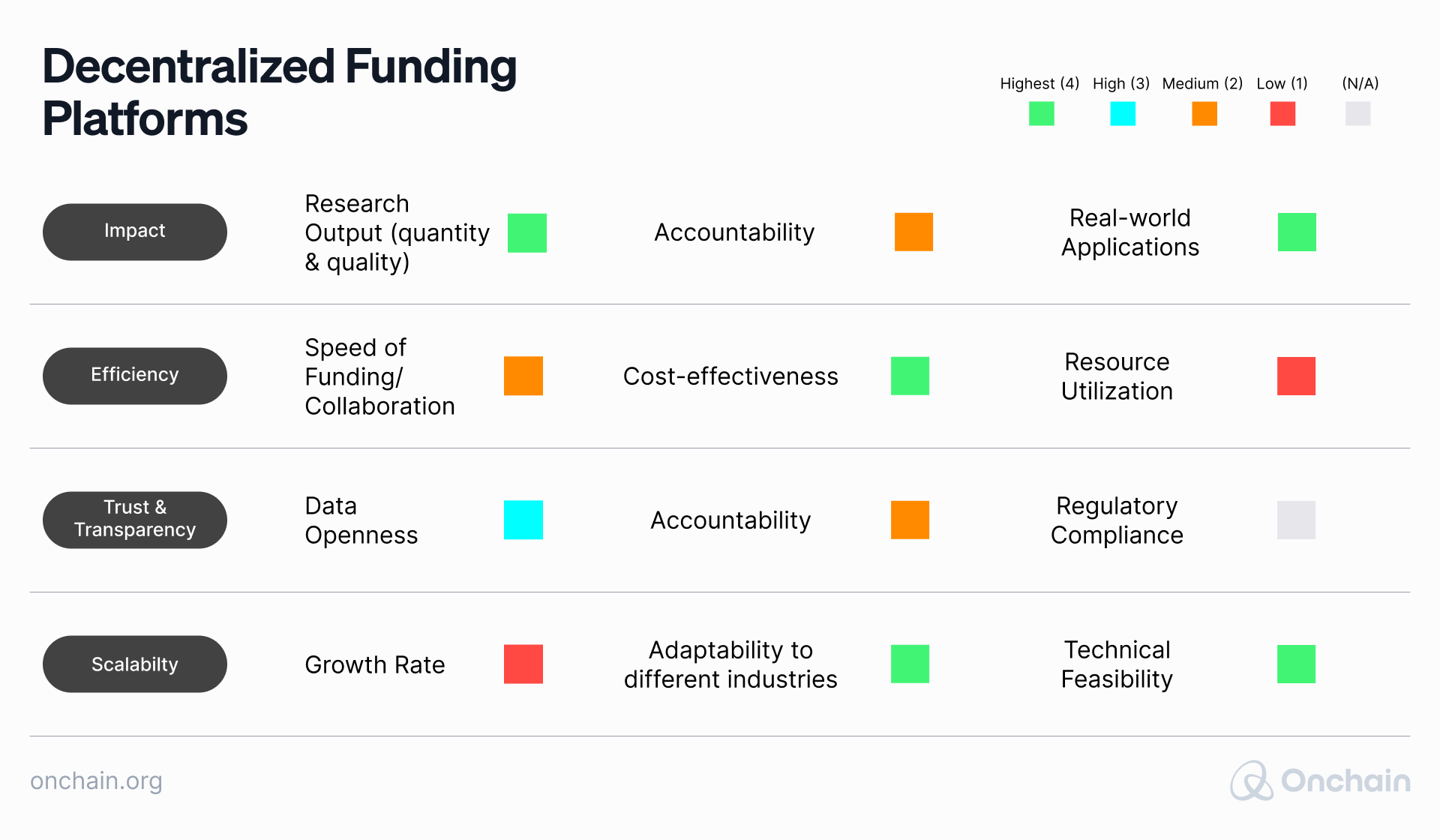
DeSci platform model 2: Collaborative research and development
Just as with universities, businesses can also leverage DeSci to engage in open, collaborative R&D projects that tap into a global pool of expertise and accelerate the development of new products, services, or technologies.
For example, Merck KGaA, a German pharmaceutical company, started a multi-year partnership with Exscientia, an AI-driven drug design project, to find new molecule drugs for cancer, neuroinflammation, and immunology. This partnership leverages Exscientia’s AI capabilities, Merck’s disease expertise, and DeSci technology to accelerate drug discovery.
On the topic of AI, decentralized science looks to be a critical player in enhancing the capabilities of this powerful technology – especially when it comes to R&D. As stated by Dr. Michael Fischer, the Founder of SVN, a protocol focused on verifying scientific data to enable AI to uncover new scientific knowledge:

The motivation to start the Scientific Verification Network (SVN) stems from a desire to create an AI capable of conducting scientific research. Achieving this requires access to clean, reliable datasets. By ensuring the accuracy and integrity of scientific data thanks to DeSci, SVN aims to finally provide a robust foundation for AI to make groundbreaking discoveries.
Our assessment shows that DeSci-based collaborative research and development models are effective and efficient, regardless of whether AI influences them. However, trust and transparency still need to be proven through research results and real-world impact.
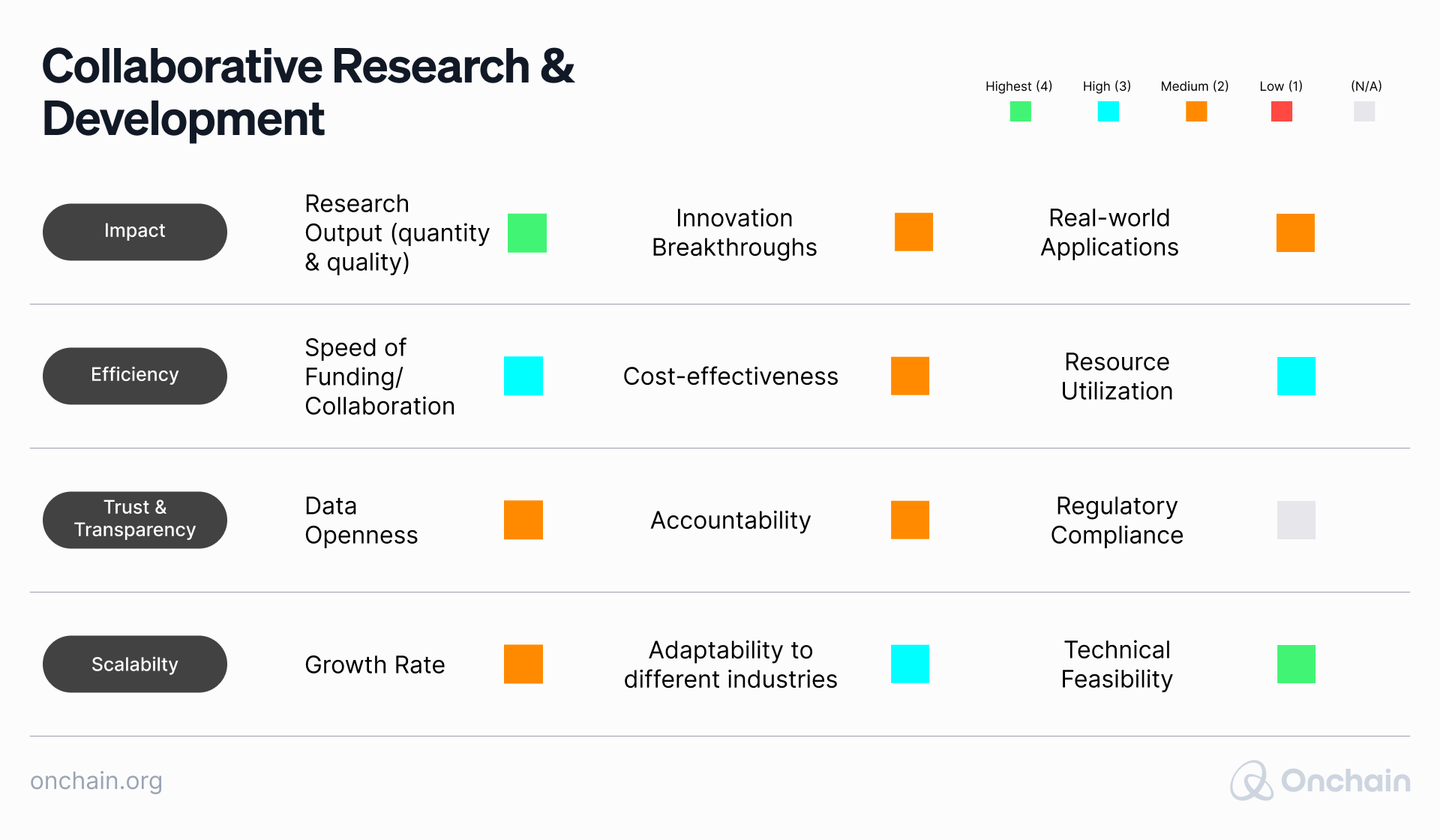

By leveraging decentralized funding and more open collaborative R&D, DeSci is well-positioned to enhance the traditional research landscape, address long-standing challenges, and promote more scalable and efficient research.
DeSci platform model 3: Decentralized data marketplaces
DeSci marketplaces facilitate the exchange of scientific resources, data, and intellectual property using blockchain technology. The aim here is to create more open, transparent, and efficient systems for conducting and funding scientific research.
Such platforms have improved the speed of collaboration and resource utilization. However, their impact on the business world is still unknown. While researchers can access and share the data via these marketplaces, it is hard to determine whether this leads to real-world applications or innovation breakthroughs.
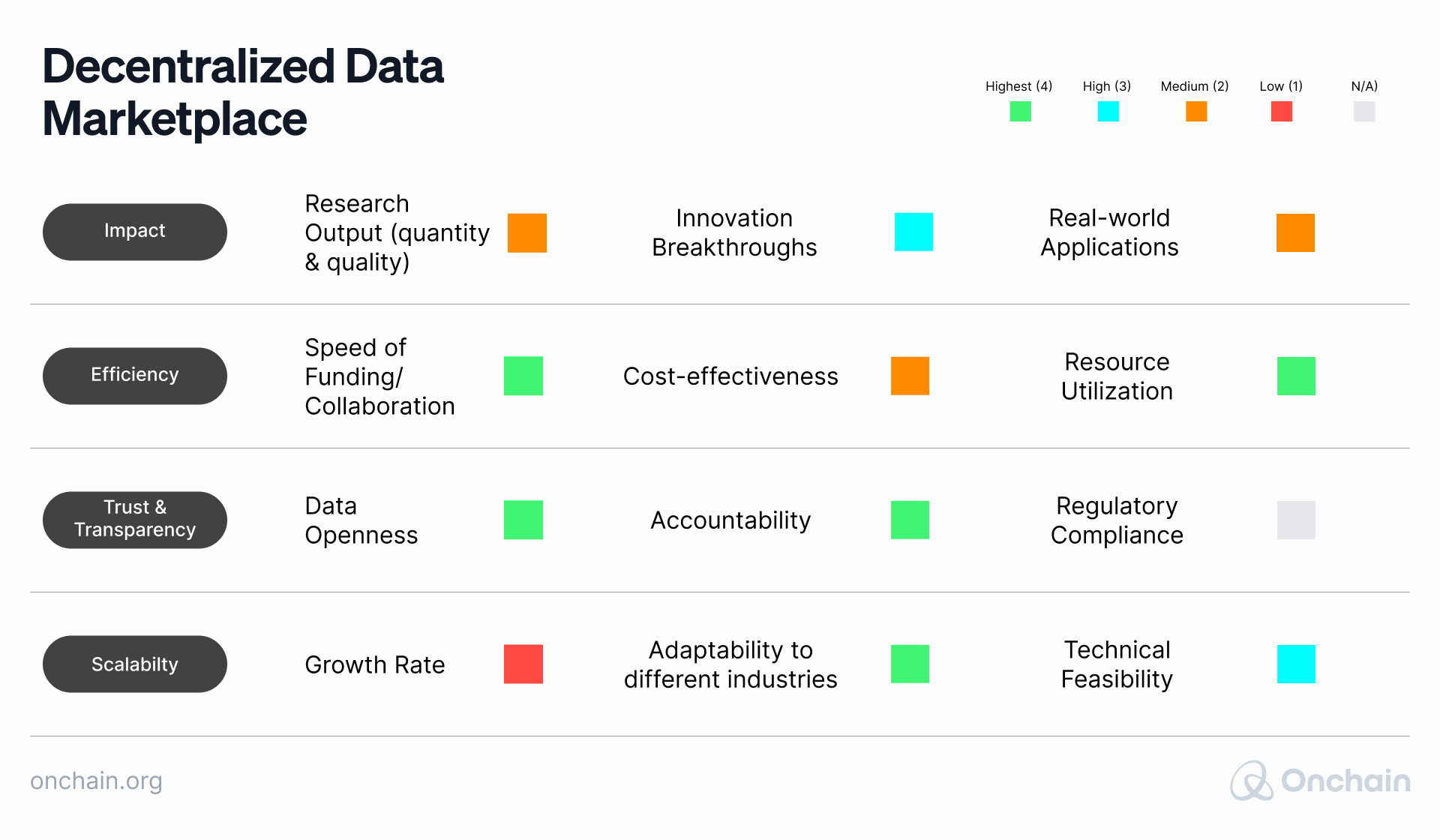
DeSci platform model 4: Decentralized clinical trials (DCTs)
DCTs are a new approach to conducting clinical research that moves away from the traditional model of participants visiting centralized research sites. These initiatives may leverage blockchain technology to manage patient data and track trial progress. Additionally, DeSci platforms can incentivize participant engagement, potentially improving the overall quality and speed of clinical research.
For example, ADAPTABLE Aspirin Dosing, a patient-centric trial assessing benefits and long-term effectiveness, was the first fully decentralized clinical megatrial of its scale, involving over 15,000 participants. It used innovative approaches like eConsent and eSource for remote data capture, patient-reported adverse events, and patient self-dosing.
Even though DCTs are effective and impactful, their scalability is yet to be tested as more healthcare companies adopt them. The regulatory framework for DCTs is not yet mature, which, in our opinion, is the biggest blocker to implementation at scale.
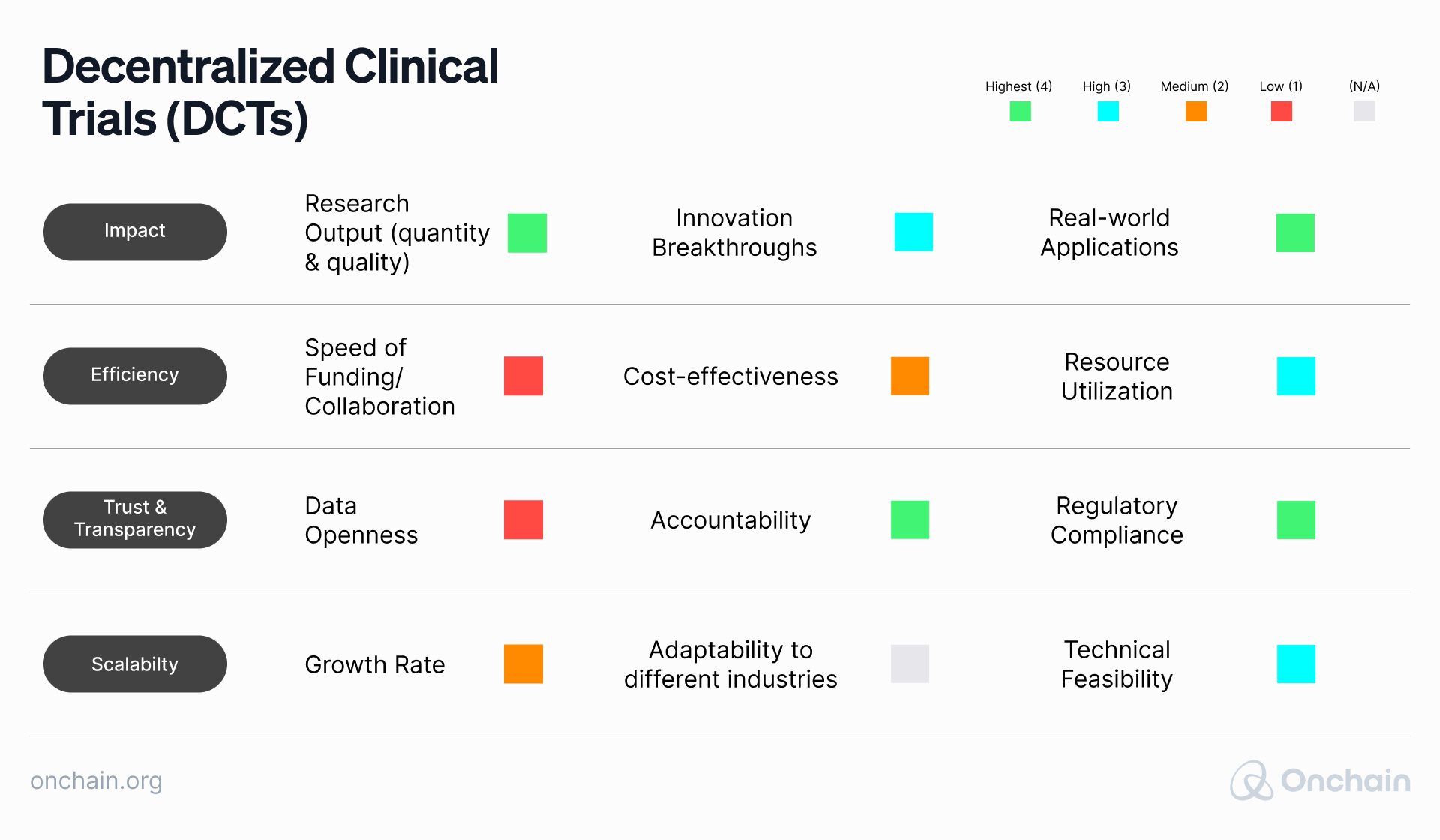

It’s a bit ironic that the most niche model – decentralized clinical trials – may turn out to be the most influential, primarily due to its clear and obvious applications. It’s worth noting, though, that it can be easily combined with others, such as data marketplaces, which can result in a really powerful DeSci tandem.
Existing business implementations of DeSci
Where exactly can the aforementioned models be implemented? There are already plenty of working use cases of DeSci in the academic world. The section below will help you understand how decentralized science may intersect with business. We’ll have a look at non-Web3 companies that partnered with various DeSci projects. But first, let’s check how familiar business representatives are with the concept of Decentralized Science.
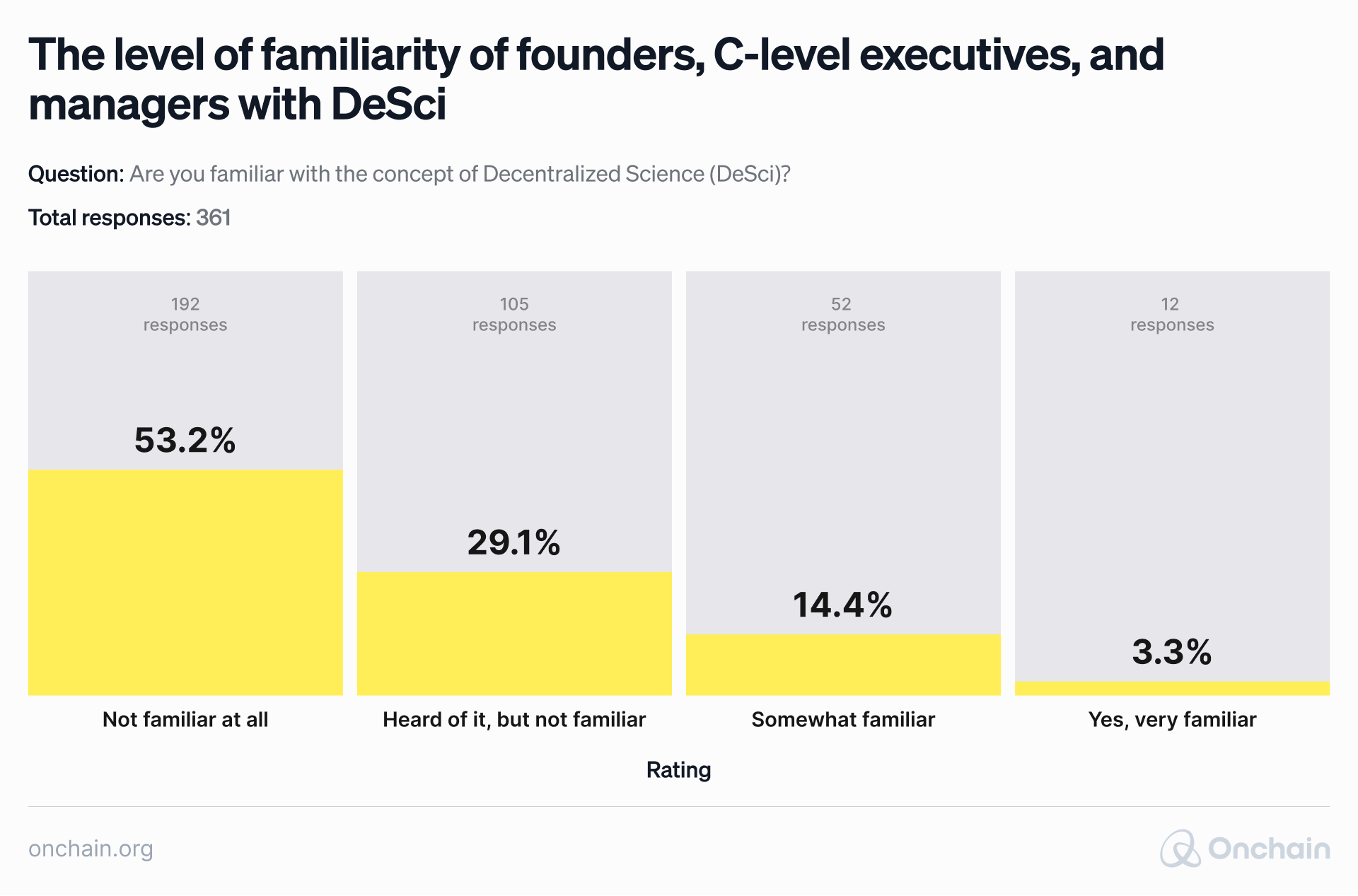
The data shows that almost 50% of respondents had at least heard of DeSci, which highlights the enormous potential of this niche. It’s not a coincidence, then, that there are already industries implementing the DeSci concept on a relatively large scale. Below, you can find the list of the absorbent ones.
DeSci in healthcare
Hippocrat, a project that leverages decentralized health data, collaborated with SolveCare Korea, another healthcare startup. SolveCare introduced Hippocrat’s blockchain-based telemedicine solution to the Korean market and is exploring joint research and development opportunities.
The company also launched a research bounty program on ResearchHub. The goal is to identify underserved populations and regions where Hippocrat’s AI-powered telemedicine application could bridge the healthcare accessibility gap.
Another example is Dynex, a neuromorphic quantum computing platform (also operating in the DePIN niche), which has formed a strategic partnership with Etica, an open-source protocol for intellectual property-free medical research. As part of this initiative, Dynex has committed some of its computing power to Etica’s open science platform. This contribution is expected to accelerate medical breakthroughs by providing researchers access to Dynex’s powerful neuromorphic computing capabilities.

Welshare Health – a real-world application of DeSci x AI in diabetes
Sponsored content by Welshare Health
TLDR
Welshare Health is developing a decentralized app to help patients personalize how they contribute to AI-driven medical research by leveraging web3 technologies.
Welshare Health is a pioneering startup at the intersection of medical research, blockchain technology and AI. Their platform empowers individuals to contribute to medical research while earning rewards and accessing personalized health offers. By leveraging the decentralized nature of blockchain and the analytical power of AI, Welshare aims to revolutionize the way medical research is conducted and healthcare is delivered.
The Problem and solution
The Problem
Traditional medical research faces significant challenges, including slow research cycles and limited access to diverse datasets. In particular, the cost of delay of a clinical trial recruitment by just a single day can be $55 million. Furthermore, the cost of lack of patient behavior insights costs $1.7 billion every single day! At the same time, individuals have little control over how their health data is used, and often do not benefit directly from participating in research studies even though 74% of patients want to share their health data for medical research purposes.
The Solution
By leveraging the power of web3 technologies as described in the section Why web3, Welshare connects patients directly with medical research, addressing the shortcomings of traditional research models and empowering individuals to take control of their health data while driving innovation in healthcare.
The App
Welshare’s app enables users to select what data they share, earn reward points and receive personalized healthcare suggestions. You can earn in-app reward points, called “Sharies”. These Sharies you will later be able to convert to crypto or fiat.
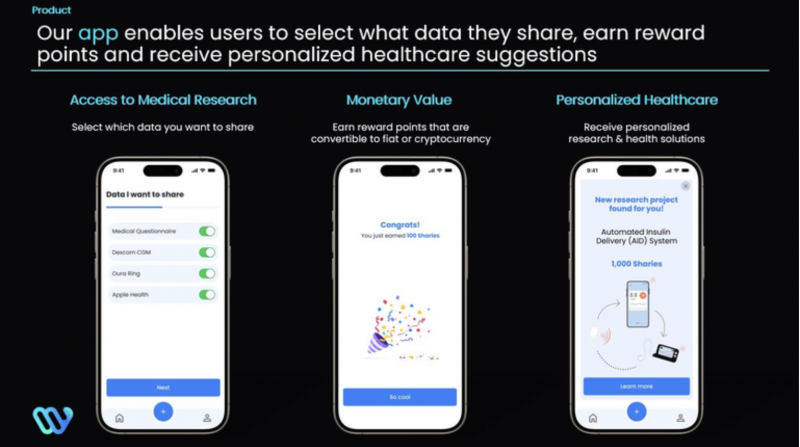
Why web3?
Web3 technology enables this medical research contribution in a way that previously was not possible. In particular, leveraging web3 enables secure data processing, ownership & monetization, and confidential compute:
- Secure Data Processing: The blockchain “smart contract” governs data access using cryptographic verification of anonymized data without the need to trust each other or intermediaries.
- Ownership Proof & Monetization: Users can own their data and cryptographically prove it is theirs without revealing their personal identity, which enables automated monetization mechanisms.
- Confidential Compute: “Zero knowledge” proofs enable algorithms to run on the data set on premise, returning solely the output of the algorithm without exposing underlying data.
Diabetes management
We know people often throw the word “AI” around carelessly, so let’s be specific and solve a real-world problem.
In the realm of diabetes management, individuals living with type 1 diabetes (T1D) face a persistent challenge: the fluctuating nature of blood glucose levels and the constant need for precise insulin dosing. In type 1 diabetes, the body’s immune system mistakenly attacks and destroys the insulin-producing beta cells in the pancreas, leading to an inability to produce insulin—a hormone essential for regulating blood sugar levels. Without insulin, glucose levels in the blood can rise to dangerous levels, causing a range of acute and chronic complications, including cardiovascular disease, kidney failure, nerve damage, and vision problems.
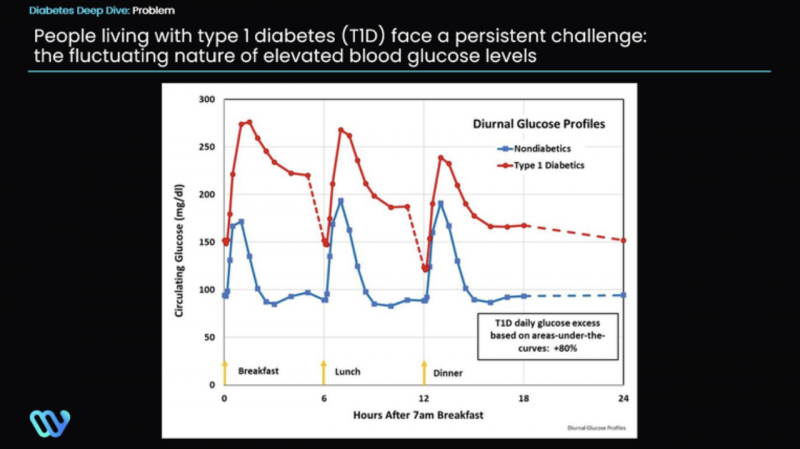
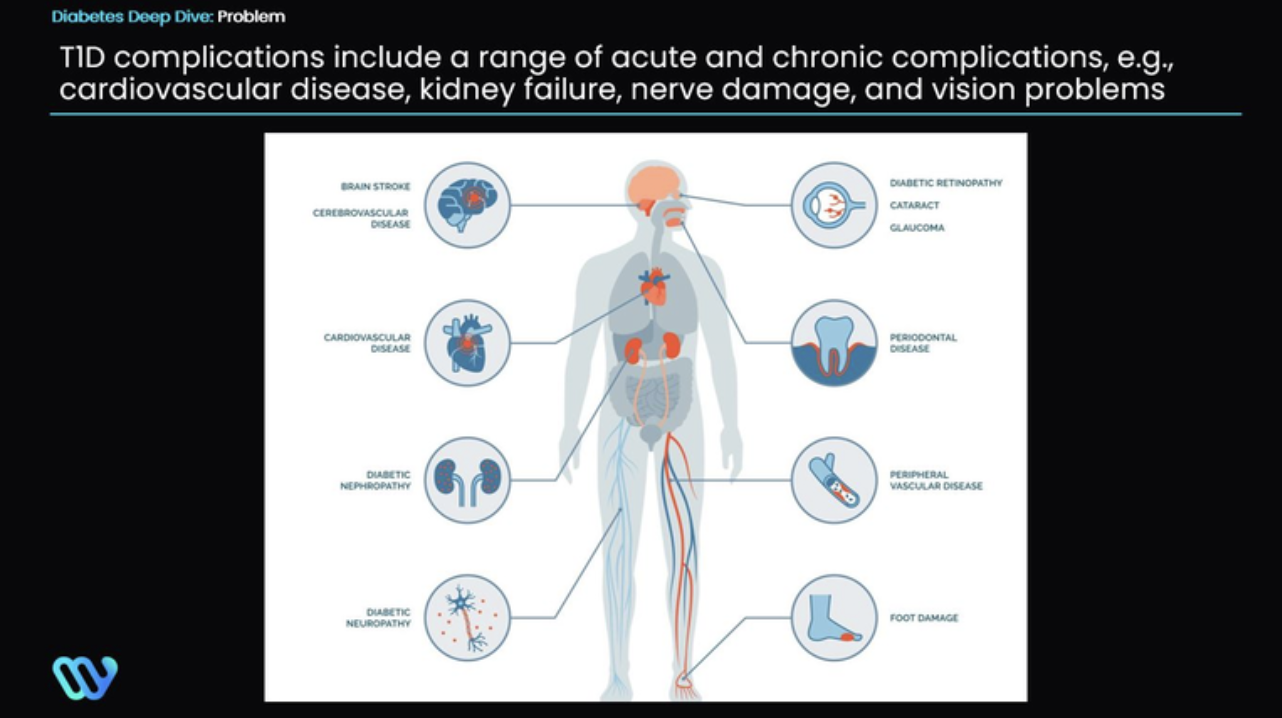
Insulin therapy
Insulin therapy is the cornerstone of type 1 diabetes management, aimed at replacing the deficient insulin and keeping blood glucose within a healthy range. However, achieving optimal glycemic control with manual insulin administration is a complex and demanding task. Factors such as diet, physical activity, stress, illness, and hormonal fluctuations can all influence blood glucose levels, requiring frequent adjustments in insulin dosage throughout the day.

AID systems
AID systems offer a transformative solution by automating aspects of insulin delivery and glucose monitoring. These systems typically consist of a continuous glucose monitor (CGM) to measure glucose levels in real time and an insulin pump to deliver insulin doses as needed. By integrating these components with sophisticated algorithms, AID systems can adjust insulin delivery in response to changing glucose levels, mimicking the function of a healthy pancreas more closely.
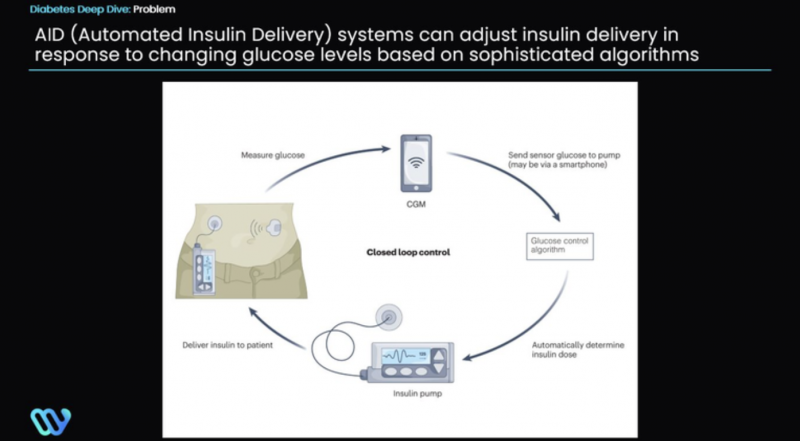
What's the problem?
However, existing AID systems often lack the level of personalization needed to effectively address the diverse physiological and lifestyle factors influencing blood glucose dynamics (such as dietary patterns, physical activity, stress levels, sleep patterns, alcohol consumption, medications, illnesses and infections). As a result, patients may struggle to achieve stable glycemic control, leading to frustration, anxiety, and an increased burden of disease management.
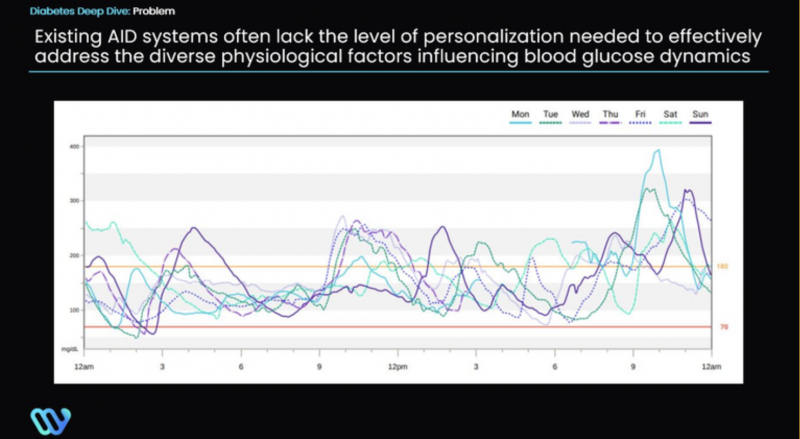
The DeSci & AI solution
In this context, the integration of Artificial Intelligence (AI) holds immense promise, offering a pathway towards the development of hyper-personalized algorithms capable of revolutionizing AID technology by personalizing insulin delivery, implementing predictive analytics, leveraging adaptive learning and integrating other components (such as wearables) of the broader digital health ecosystem, hence transforming the lives of individuals living with diabetes.
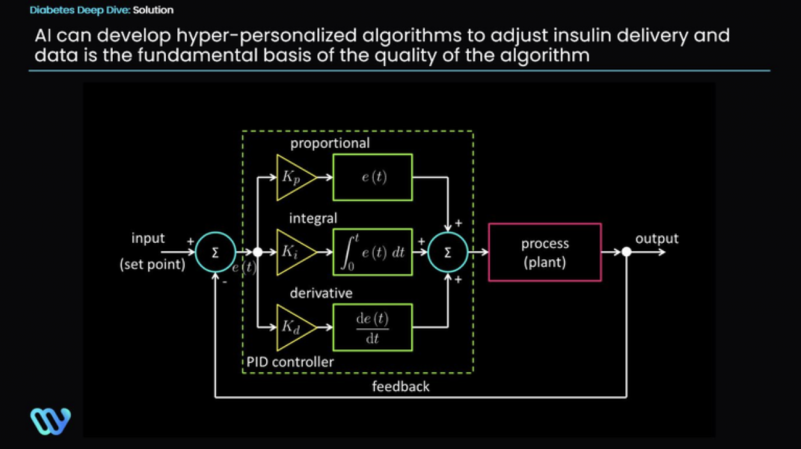
The synergy between DeSci and AI within Welshare Health’s solution creates a dynamic ecosystem where individuals are not merely passive data contributors but active participants in advancing medical knowledge. Through decentralized governance mechanisms and smart contracts, users are incentivized to share their data ethically and responsibly, ensuring a fair and equitable distribution of rewards. Additionally, AI-driven insights empower users to make informed decisions about their health, driving proactive engagement in preventive care and disease management.
DeSci in pharma
Galeon is a project focused on electronic health records (EHR) and medical AI. It recently announced a partnership with HCS Pharma, a healthcare company focused on medical research and drug development. The collaboration aims to connect hospitals through a shared patient record system developed by Galeon, enabling structured data collection and utilization for medical research and new treatment discovery.
DeSci in biotechnology
VitaDAO, a prominent DeSci project known for longevity research, received $12.7mil in its 2022 round of funding from investors, including biotech giant NorthPond Ventures. In 2023, it obtained further funding from Pfizer Ventures, making Pfizer the first pharmaceutical company to vote on a DAO proposal. In turn, VitaDAO has been able to allocate funding to various research projects, with the first being a longevity research project by Scheibye-Knudsen Lab in Denmark.
DeSci in supply chain
OriginTrail is a blockchain-based platform that built a decentralized network for storing, sharing, and verifying data in the form of a knowledge graph (structured representation of information in nodes and edges to enable complex querying, inference, and visualization). Various companies use it for supply chain tracing and to authenticate certificates, art, and diplomas.
According to CIMdata, OriginTrail has partnered with Oracle, the scope of which integrates OriginTrail’s network with Oracle’s Blockchain Cloud Service. This will enable Oracle’s users to leverage OriginTrail’s solutions and facilitate trusted data sharing along supply chains.
Moreover, according to the article in PRNewswire, over 40% of US imports, including companies like Walmart, Costco, and Home Depot, are exchanging security audits using OriginTrail’s Decentralized Knowledge Graph (DKG), which converts information into an NFT. This is one of the most prominent examples of DeSci adoption in business to date.
The Decentralized Knowledge Graph isn’t limited to large enterprises and industries such as supply chain management. For instance, OriginTrail is an open framework for developing trusted AI applications that launched a tool called ChatDKG. It utilizes OriginTrail’s Decentralized Knowledge Graph to provide a secure and transparent foundation for AI models. This makes it a potential “decentralized contender” to the well-known centralized generative AI (we bet you can guess the name!).
We tested OriginTrail’s platform as an individual user. Our goal was to analyze its alignment with DeSci principles, such as decentralized data sources and collaborative and transparent information collection.
Onchain experiment: Using ChatDKG as ChatGPT
Below are the steps we followed to query the platform:
Step 1
Go to the ChatDKG app: chatdkg.ai/ask
Step 2
Input a prompt describing what you would like to generate (see the example in the image below) and click the send button to submit the prompt.
Step 3
Wait a few minutes until the result is generated. Along with the results, you will see the actual knowledge/data from which the AI model generated the result (see the image below).
Step 4
See the expanded version of one of these knowledge/data examples in the below image.
We asked DeSci-specific questions as these should be easily answerable by a decentralized science project such as OriginTrail. The prompts we used were:
- Do you know about decentralized science?
- What are the benefits of DeSci?
- How does DeSci help the supply chain?
- Can you give some examples or use cases in this area?
- Can you tell me the various challenges that DeSci solves?
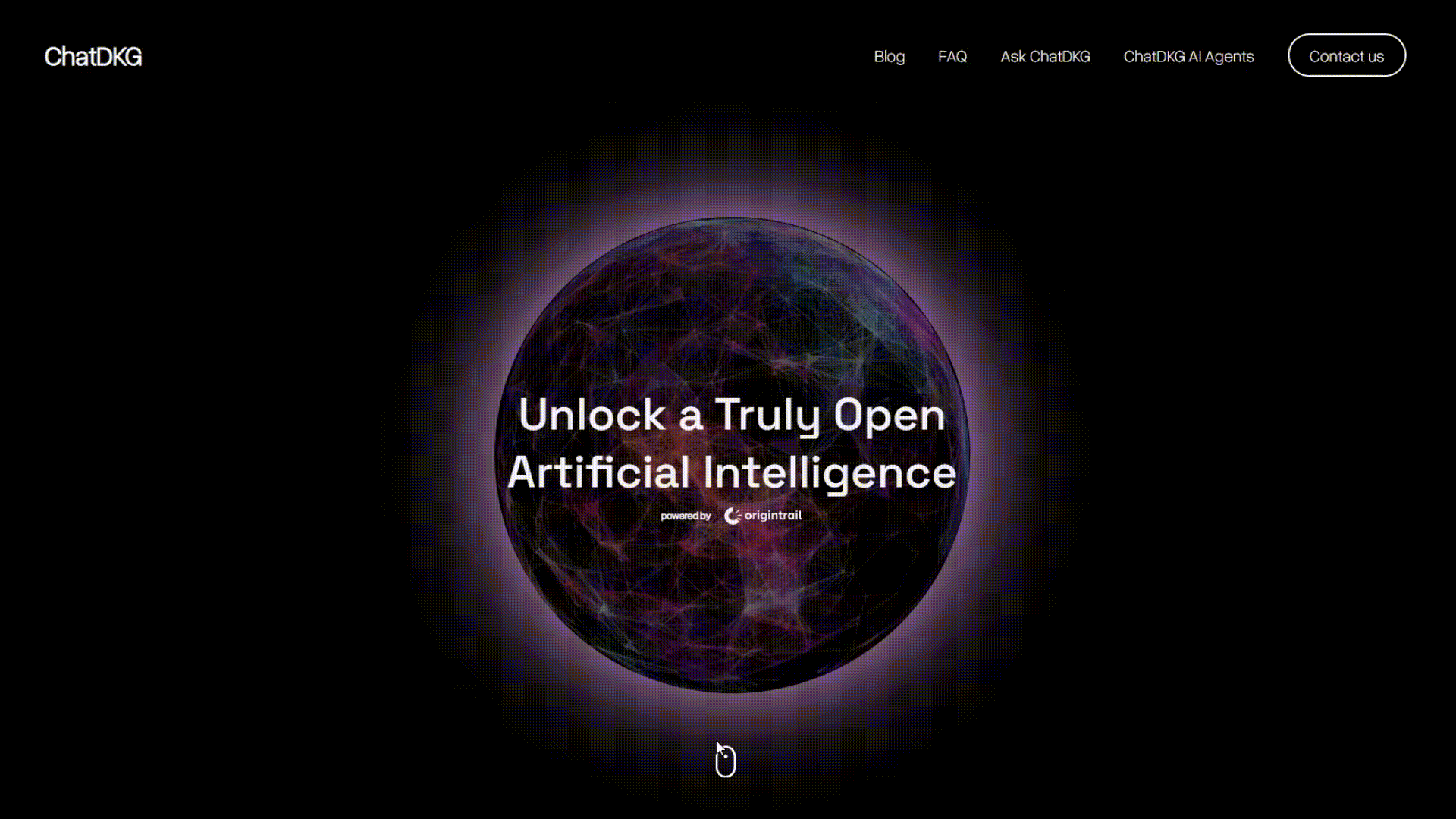
Our initial finding was that the platform aligns with several fundamental DeSci principles:
- We could see where the information was pulled from, which was very helpful. We equate it to knowing who wrote a book, which helps decide if the content is trustworthy.
- Utilizing a blockchain-secured knowledge graph aligns with DeSci’s commitment to transparency and data integrity. No single person or group controls the information, making it more fair and accurate.
- The open-source approach to data collection is great, fostering collaboration and transparency in building a comprehensive knowledge base.
However, ChatDKG’s current performance presents challenges that need to be addressed for wider adoption:
- In comparison to established AI platforms like ChatGPT or Google Gemini, ChatDKG’s generated responses lack coherence and relevance. This may lead to confusion and misinterpretation, limiting its usefulness in professional settings.
- The platform tends to focus excessively on AI-related details, sometimes missing the core intent of user queries.
We didn’t expect ChatDKG to compete with its centralized competitors, but its performance fell short of our expectations for a robust AI knowledge-sharing tool. However, the project is still in the early stage of development. We believe significant output quality, relevance, and coherence improvements are necessary before wider adoption occurs. This is especially important since applying DeSci mechanisms into ChatDKG may pave the way for more transparent and reliable AI chatbots.
DeSci in spacetech
This section may surprise you, but several projects focus on non-scientific “space knowledge” implementations. For example, SpaceChain, a blockchain software company that develops open-source satellite software, is collaborating with NASA to explore using blockchain technology in space-based applications.
On a smaller scale, the following companies collaborate to democratize access to space data, which is typically very siloed: Copernic Space, a blockchain-based space asset marketplace; Cudos, a decentralized cloud computing network; and Homeport.Network, which is run by the satellite data infrastructure provider Sfera Technologies, is creating a marketplace for tokenized satellite imagery and Earth Observation data. This partnership aims to make space assets more accessible and affordable to a broader commercial market.
DeSci in wearable technology
The final DeSci x business application we reviewed is related to DeSci-influenced wearables. For example, the Rejuve.AI app, which aims to democratize longevity and healthy aging, has partnered with BIOSTRAP, a company that develops advanced wearable devices for health monitoring and data collection. This partnership aims to integrate BIOSTRAP’s wearable technology into Rejuve.AI‘s longevity ecosystem, enabling users to contribute their health data seamlessly through these devices.
The growth of Rejuve.AI is dependent on the quality of its app and its effectiveness in encouraging users to share sensitive information. Therefore, we decided to conduct one more experiment for the purpose of this report.
Onchain experiment: Rejuve.AI application
We wanted to know how this application aligns with DeSci values. To evaluate it, we tested the platform’s main features (and a few more) over one week.
Below are our main findings categorized by the most important DeSci mechanisms for sharing health data.
1. Rewarding participation
Rejuve.AI offers an ecosystem where members are rewarded with RJV tokens, the native cryptocurrency of the Rejuve.AI ecosystem, for their contributions. The platform incentivizes participation through various means, including sharing health data and connecting wearables.

Reflection:
As part of this experiment, we logged data related to nutrition, vitality, activity, and sleep for three consecutive days, earning 0.5 tRJV (test RJV tokens – used within the app’s beta version) each day.
The app also offers the option to track macro and micronutrients, but we chose not to add this information. As average users, we don’t typically monitor our daily consumption of carbohydrates, dietary cholesterol, or eicosapentaenoic acid (EPA). Notably, the app could have made more effort to guide us on which metrics are truly valuable or worth tracking. This lack of guidance made us uncertain about which data points would be most beneficial for both our health monitoring and the platform’s research objectives.
2. Personalized insights
Rejuve.AI promises to provide members with personalized insights based on their contributed data and collective research.
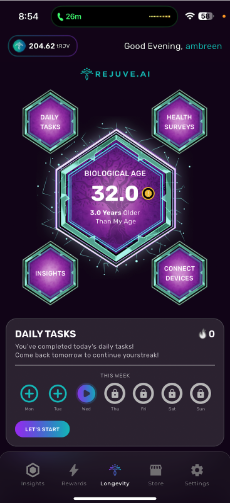
Reflection:
Insights are divided into two sections: Health and hallmarks.
- The health section tracks six categories: Body weight, exercise, food & diet, sleep hygiene, supplements, and lifestyle. For each category, the app classifies the status as below average, moderate, or excellent. These insights were easy to understand, and we could clearly see how the data we logged daily was used to generate these assessments.
- On the other hand, the hallmarks section measured ten metrics referred to as “Hallmarks of Aging.” Surprisingly, we ranked excellent on all ten metrics. However, it was not evident how this information was being generated. Was it explicitly based on the information we logged daily? Or was it derived from a sample of individuals with characteristics similar to ours?
Most importantly, generating actionable insights from this information was quite challenging. For example, if we had scored below average on Telomere Attrition, what lifestyle changes should we make? Could we improve this through supplements or exercises? The app provided no clear guidance on these questions.
This lack of explanation and actionable advice made it difficult to fully utilize or trust the hallmarks section despite its apparent sophistication.
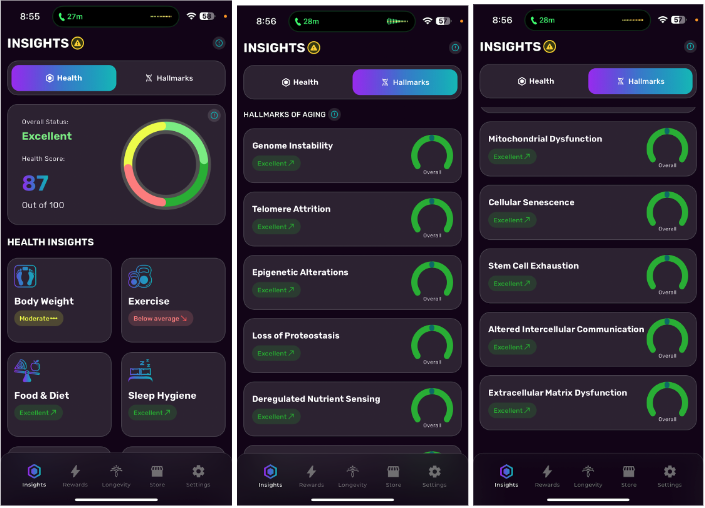
3. Using the collected tokens
Our final question refers to another important outcome of interacting with the Rejuve.AI app. How can we use the tokens we collected for our activities?
Reflection:
The tokens accumulated through daily data logging can be redeemed in the in-app store to purchase supplements, wearables, and health testing kits. An interesting feature is that accumulated RJV tokens can only be utilized by participating in the upcoming “Data NFT program.”
The data NFT serves as a special network token that links individuals to their data, identifying them as unique participants in the network. These tokens are used to build apps, research drugs, or create treatment plans and are stored on the Rejuve AI’s platform in the form of pNFTs (product NFTs). Whenever a pNFT is minted per product ideation, pNFT shards are distributed to users proportionally based on their contribution to that product, calculated by an AI algorithm.
However, the app currently doesn’t provide any links or guidance on how to get involved with these experiments, suggesting that this feature may still be under development.
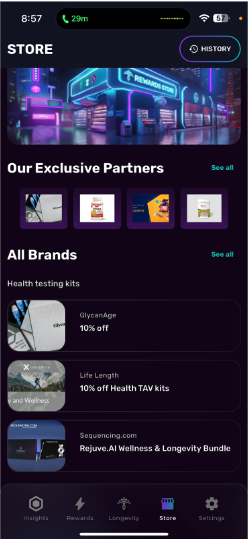
Conclusion
Rejuve.AI’s commitment to democratizing longevity research through a decentralized platform is commendable. However, the current limitations in user guidance, actionable insights, and the underdeveloped “Data NFT program” suggest that the platform is still in its early stages.
One intriguing feature was its comparison of one’s biological age to chronological age. It is important to note that the basis for calculating biological age is not clearly explained at this stage. This raises questions about the methodology and accuracy of this comparison and the app’s overall readiness.
To fully realize its potential in advancing longevity research and providing value to users, Rejuve.AI needs to focus on enhancing user education, improving the actionability of insights, and developing clear pathways for users to participate in and benefit from the research process.

The Data Lake use case study
Sponsored content by Data Lake
Who is Data Lake?
In recent years, blockchain technology has predominantly been associated with decentralized finance (DeFi), revolutionizing how financial transactions and assets are managed. However, its potential extends far beyond financial applications. Despite the focus of many decentralized science (DeSci) projects on funding mechanisms, blockchain can facilitate more advanced use cases within the scientific domain.
One such use case leverages blockchain for its intrinsic feature: an immutable proof of truth. Traditional science (TradSci) often relies on paper documentation, whereas decentralized science (DeSci) thrives in the digital realm. This creates a gap where DeSci clearly outpaces TradSci on several fronts, such as decentralized clinical trials, funding or tokenization of IP. Blockchain is instrumental in bridging this gap, complementing TradSci and helping it step into the future of science. A prime example of this synergy is Data Lake, a decentralized patient recruitment platform. Data Lake empowers patients by putting control over their consents and medical data back into their hands and quite funnily, indirectly addresses the environmental concerns associated with paper-based consents for medical data usage. This initiative not only modernizes data management but also aligns with ethical standards, highlighting the transformative potential of blockchain in healthcare and scientific research.
The case study
This case study explores how Data Lake, leveraging blockchain technology, collaborates with Sanofi Poland to create a registry for patients with Acid Sphingomyelinase Deficiency (ASMD) called PASMO (Patient Pathway ASMD Optimisation). This project exemplifies how blockchain can be utilized to enhance traditional scientific research and medical practices. By providing a secure, transparent, and decentralized platform for patient data management, Data Lake’s initiative represents a significant step forward in the application of blockchain in healthcare, aiming to improve diagnosis and treatment outcomes through the integration of artificial intelligence (AI).
The key player within the 3B$ problem
Here we will focus on the problem with medical data shortage and patient recruitment. About how it was done until today, how traditional consent collection looks like and how limited the processes of patient recruitment are within traditional CROs. We will touch upon the amount of patients with ASMD and how small the sample is, showing that the traditional way just won’t work here.
Challenges addressed
Patient recruitment is a significant challenge in every clinical study. Globally, nearly 80% of all clinical studies fail to finish on time while cost of patient recruitment amounts to up to 40% of the total cost of a clinical trial.
This is because most of the clinical trials have lengthy and complicated inclusion and exclusion criteria, while the tools offered to medical personnel to onboard patients to research are cumbersome and ineffective.
Moreover, informed consent forms (ICFs) are a critical document for auditing the compliance and validity of data collection. Most of the time, the consents are stored on paper, giving little control and transparency to both patients and auditors.
There’s a clear need for a tool that would provide adequate levels of security, transparency, compliance and comfort for both patients and researchers.
The DeSci solution
How technology can empower TradSci
Here we will focus on how the consent technology works, how it differs from the centralized way and how it helps us effectively enroll patients within the referral network. We will touch also on the technology behind it, the chain and the hashing algorithms in the smart contract.
Traditionally, consent collection relies on paper and centralized systems where data is stored in siloed databases managed by individual organizations. This centralized model is prone to breaches and errors, as well as issues with data integrity and accessibility. In a centralized system, data is often duplicated across various stakeholders, increasing the risk of inconsistencies and unauthorized access. In contrast, blockchain ensures that patient consents are immutable and easily verifiable via smart contracts.
Blockchain technology, as utilized by Data Lake, transforms the consent process by providing a decentralized, secure, and transparent system. Unlike centralized methods, blockchain ensures that patient consents are immutable and easily verifiable through smart contracts in case of any dispute from either side of a researcher or a patient. These smart contracts use hashing algorithms to secure data, ensuring that only authorized users can access sensitive information. This technological advancement facilitates efficient patient enrollment through a referral network, overcoming the limitations of traditional methods and ensuring robust data integrity and patient trust.
In this decentralized model, patients can manage their own consents, significantly enhancing trust and data integrity. This system allows for seamless patient enrollment through a referral network, efficiently overcoming the bottlenecks of traditional recruitment methods. The blockchain used by Data Lake provides a tamper-proof ledger, ensuring that every consent is recorded and unchangeable, thereby maintaining a high standard of transparency and accountability.
The Data Lake advantage
To comply with legal standards and protect personal data, Data Lake uses a process where personal data is mixed with a ‘salt’—an additional random string of words—and then hashed using the Keccak-256 algorithm. This method ensures that personal data is not directly published on the blockchain, adhering to privacy regulations. The Keccak-256 algorithm generates a unique, fixed-size hash from the salted data, making it impossible to reverse-engineer the original information without knowing the exact salt. This technique secures sensitive patient data while maintaining the transparency and immutability of the blockchain.
By integrating this technology, Data Lake not only modernizes the consent collection process but also aligns it with the needs of traditional science. It supports efficient patient recruitment, ensuring a robust and diverse data set crucial for developing effective treatments, particularly for rare diseases like ASMD. This approach exemplifies how decentralized technology can enhance traditional scientific methodologies, paving the way for more efficient and secure research practices.
In the case of the ASMD registry, establishment of a decentralized, transparent data access management system through auditable Informed Consents helped to secure buy-in and support of both scientific community and patients.
Consent issues
More than just medical data
Here let’s focus on being sector agnostic, showing the need for consents and research projects within other sectors such as banking. Show technology such as BLIK that makes you able to pay in seconds with a unique code, but when signing a consent, there’s several paper copies. Show how Data Lake falls into the category of DeSci, AI, DeFi, etc. and that it’s a beast.
The need for secure and efficient consent and data management systems extends far beyond the medical sector, impacting industries such as banking, finance, and more. The BLIK payment system in Poland is a prime example of how technology can streamline processes that traditionally relied on cumbersome methods.
BLIK allows users to make instant payments using a unique, temporary six-digit code generated through their banking app. This code is valid for a short period, adding a layer of security, and must be confirmed by the user within the app to complete the transaction. BLIK facilitates a variety of transactions, including in-store and online purchases, ATM withdrawals, and peer-to-peer money transfers, all without the need for physical cards or detailed banking information.
In contrast to the simplicity and efficiency of BLIK, traditional consent collection for services such as medical research often involves multiple paper copies, manual signatures, and lengthy processing times. This method not only delays the process but also poses significant risks to data security and integrity. Data Lake’s use of blockchain technology in consent management addresses these challenges by providing a decentralized, secure, and transparent system.
Consent on Data Lake
Personal data is not published on the blockchain directly. Instead, it is mixed with a salt and hashed using the Keccak-256 algorithm, creating an immutable record that ensures data integrity and privacy. This method aligns with legal standards, protecting sensitive information while leveraging the blockchain’s benefits of immutability and transparency. By combining these advanced technologies, Data Lake can efficiently enroll patients through a referral network, overcoming the limitations of traditional patient recruitment methods. This approach ensures robust data integrity and patient trust, making the process more efficient and secure.
The underlying principles of Data Lake’s technology are applicable across various sectors. Just as BLIK simplifies and secures financial transactions, blockchain can transform consent and data management in industries such as banking, logistics, and beyond. For instance, while BLIK enables quick payments with a simple code, consent processes in banking often still rely on multiple paper forms, which are prone to delays and errors.
Data Lake exemplifies the convergence of decentralized science (DeSci), artificial intelligence (AI), and decentralized finance (DeFi). Its sector-agnostic approach not only modernizes consent processes but also enhances data security and user empowerment across various fields. This versatility highlights Data Lake’s potential as a transformative force in integrating advanced technology into traditional industries, paving the way for more efficient, secure, and user-centric practices.
Conclusion
Data Lake’s innovative use of blockchain technology positions it as a pivotal player within the decentralized science (DeSci) ecosystem. By addressing the critical issues of data integrity, security, and patient empowerment, Data Lake bridges the gap between traditional science (TradSci) and modern, decentralized methodologies. The collaboration with Sanofi Poland on the PASMO registry for ASMD patients showcases how blockchain can transform patient recruitment and data management, making the processes more efficient, transparent, and secure.
The PASMO project exemplifies the transformative potential of blockchain in healthcare. By ensuring that patient consents are immutable and verifiable through smart contracts, Data Lake enhances the integrity and security of sensitive patient data. The use of advanced hashing algorithms and decentralized storage ensures compliance with legal standards and protects patient privacy, fostering greater trust and engagement.
Beyond healthcare, Data Lake’s technology has broad applicability across various sectors. Its sector-agnostic approach can enhance data management and consent processes in industries such as banking, finance, and logistics, driving efficiency and reducing the risks associated with traditional, paper-based methods. This versatility highlights Data Lake’s potential as a transformative force in integrating advanced technology into traditional industries, paving the way for more efficient, secure, and user-centric practices.
In the DeSci ecosystem, Data Lake exemplifies how advanced technology can complement and enhance traditional scientific methods, paving the way for more effective and ethical research practices. By integrating blockchain and AI, Data Lake not only addresses current challenges in medical research but also sets the stage for future innovations, solidifying its place as a leader in the evolution of decentralized science and technology. The PASMO project serves as a compelling example, showcasing the tangible benefits and far-reaching impact of blockchain technology in the real world.
DeSci - impact assessment
Now that you’ve learned about the abundance of DeSci models, platforms, and real-world use cases, you’ll want to know the true potential.
Is all this enough to convince scientists to move away from TradSci into a decentralized space? Can it persuade entrepreneurs to build DeSci projects? Or at least utilize DeSci mechanisms to make the research for their business purposes “great again”?
To answer this question, the Onchain research team members rolled up their sleeves again and went to work. Here’s what we did:
- We identified the top challenges in the world that scientific research could help solve.
- In a thought experiment, we conceptualized how the discovered DeSci projects and mechanisms could address them.
- We evaluated how well the existing DeSci use cases fit these ideas and outlined the most compatible ones.
- We listed the enablers and blockers that could determine the future of these intersections.
- We selected the DeSci platform models with the highest impact potential.
Below, you’ll find separate impact assessments for each of the discovered challenges.
Challenge 1: Climate change
How can DeSci address climate concerns?
A growing number of companies and funds are explicitly focused on grants to combat climate change. Facilitating this through DeSci would make the process more transparent and potentially more efficient.
At the same time, DeSci can address climate change directly. Reducing the carbon footprint using unused computing power is a promising scheme—DePIN and DeSci working in tandem.
Existing DeSci use cases
Surprisingly, we didn’t find any existing projects that focused specifically on climate-related issues. Considering its urgency, importance, and the attention it receives, we see it as a promising business opportunity.
We did find working projects addressing the decentralization of computing power. These projects can make processes with high energy consumption, such as running AI algorithms, more efficient. Examples include Dynex, Nuco.cloud, or even less DeSci-oriented DePIN companies like Akash.
Critical success factors
- Creating a narrative linking DeSci to climate change activities is critical. This doesn’t exist till now.
- The community must be involved in data collection (citizen science) and funding initiatives.
- Building trust in decentralized platforms for climate data is necessary.
- There’s a need to secure continuous funding from decentralized sources.
Obstacles and bottlenecks
- Climate data sources are diverse and not standardized.
- Interoperability with sensors or data sources and compliance with existing laws is not straightforward on public blockchains.
- We expect that additional challenges will surface after these two are overcome.
Proposed platform models
- Decentralized funding platforms.
- Decentralized data marketplaces.
Challenge 2: Fake news and misinformation
How can DeSci address the fake news problem?
It’s a challenge that DeSci can tackle directly, especially misinformation in research and academia. All open-access platforms we discovered address it through collaborative peer reviews and decentralized data evaluation from papers.
In addition, access to more decentralized data sources (incentivized) may also contribute to more reliable information spreading across the Internet.
Due to the relatively high number of projects operating in healthcare, there’s enormous potential for combating misinformation in these areas. Imagine replacing global misinformation with personalized insights based on incentivized data sharing (e.g., Galeon).
Existing DeSci use cases
Similar to climate action, we see this as an opportunity for socially-oriented entrepreneurs to drive change using DeSci.
Take these projects as promising examples of addressing misinformation in healthcare: Both Galeon and Rejuve.AI generate personalized insights instead of general, often questionable information from the internet.
Critical success factors
- It’s vital to create a narrative that links combating fake news and misinformation to DeSci. At the moment, there is little awareness.
- Projects need to shift the focus toward the high credibility and value of papers and innovations conceptualized thanks to DeSci. Currently, a quantity-oriented mindset is used to demonstrate the platform’s traction to potential inventors. Raising awareness of the unique benefits will be necessary in the long run.
- It’s necessary to create reputation systems that assess the credibility of news sources based on community feedback and algorithmic analysis.
- Tokenized incentives to reward users for fact-checking and identifying misinformation proactively must be implemented.
Obstacles and bottlenecks
- Incentivizing could lead to biases in data collection. Imagine a group of opportunistic crypto speculators submitting 50% of the data set.
- Convincing traditional media to adopt decentralized verification systems is a challenge.
- Convincing the public to trust in DeSci and use decentralized verification platforms is equally challenging.
- Integrating DeSci platforms with existing news and social media platforms. This poses a technical hurdle due to technological differences, data formats, and business models.
Proposed platform models
- Decentralized data marketplaces.
Challenge 3: Cybersecurity risks
How can DeSci address cybersecurity challenges?
Incentivized data sharing may be an effective solution to cybersecurity issues. Solving them relies on the ability to identify the problems which require large amounts of data input.
Also, the variety of cybersecurity-related problems is huge and constantly evolving. Collaborative research of experts in different fields would make this area more effective.
And similar to other energy-consuming operations, decentralized computing power providers could significantly support efforts to combat cybercrime and ensure cybersecurity.
Existing DeSci use cases
When it comes to additional computing power, Dynex, Nuco.cloud, or less DeSci-oriented DePIN companies such as Akash are practical options.
Open science DeSci platforms lend a strong helping hand for incentivizing and facilitating collaborative research. Examples are ResearchHub, Preprints, or DeSci Labs, which also offers decentralized storage.
There are also decentralized threat intelligence marketplace platforms, such as PolySwarm. These incentivize security experts to contribute and evaluate threat data.
Critical success factors
- It’s essential to raise coders’ interest in the DeSci space.
- Facilitating seamless collaboration between programmers is vital. DeSci platforms are tailored for academia rather than for coders, who often lack scientific experience and might find it challenging to interact with them. Therefore, projects that also cater to coders’ needs and habits need to be developed.
- Decentralized bug bounty programs, such as those hosted by Immunefi, can play an important role in attracting the attention of programmers.
- Dedicated projects or a merger that creates a DeSci platform specifically for cybersecurity issues must be established.
Obstacles and bottlenecks
- As before, potential biases in data collected due to incentivization.
- Interoperability issues between different DeSci platforms using different networks and standards.
Proposed platform models
- Collaborative research and development platforms (especially if cybersecurity-focused).
- Decentralized data marketplaces.
Challenge 4: Healthcare concerns
How can DeSci address healthcare issues?
DeSci has already made a significant impact on healthcare.
The mechanisms vary per specific need. However, we can summarize DeSci’s support for health-oriented innovations in 5 areas:
- Collecting valuable data directly from patients.
- Enabling collaboration between different stakeholders (patients, researchers, institutions, grant providers, etc.).
- Making medical research more accessible.
- Prioritizing research processes in a democratic (decentralized) way.
- Improving the transparency and accuracy of grant capital allocation.
Existing DeSci use cases
We have covered the list of promising innovations and analyzed their unique characteristics and DeSci mechanisms in the “DeSci landscape” section above.
Critical success factors
- Wider adoption on a higher level, including institutions and government of DeSci platforms, is crucial.
- There’s a need for working use cases where patients benefit from improved treatment and token incentives.
- General data integrity and security are an absolute must.
- It’s necessary to implement interoperability solutions for seamless data exchange.
Obstacles and bottlenecks
- The high number of platforms available – it’s an early stage, but from the researcher’s or institutional perspective, it’s challenging to decide which solution to use.
- Same as above, potential biases due to incentivized data collection practices.
- Tokenomics – most DeSci healthcare tokens are extremely inflationary.
- Regulatory issues for approval and commercialization.
- Interoperability between different institutions is necessary for seamless data exchange.
Proposed platform models
- Decentralized funding platforms.
- Decentralized data marketplaces.
- Collaborative research and development platforms.
- Decentralized clinical trials.
Challenge 5: Inequality
How can DeSci address inequality?
Economic inequality and disparities in access to quality information and resources are significant global challenges. DeSci platforms can level some of the imbalances by democratizing access to high-quality data, education, and economic opportunities.
DeSci can create new economic opportunities by enabling individuals to monetize their scientific contributions through tokenized rewards. Participating in research projects that address local challenges and create solutions with market potential can be rewarded.
Existing DeSci use cases
At the moment, it’s more of a promising opportunity than a solution being explored. While a direct equivalent to a decentralized Bloomberg Terminal doesn’t exist yet, the concept envisions a platform that, much like the Bloomberg Terminal in finance, would provide comprehensive, real-time data and analysis. However, it would do so in a decentralized, accessible manner, breaking down barriers that typically keep such high-quality information exclusive to a few.
For example, Ocean Protocol and OriginTrail could be used to offer decentralized data exchange and knowledge graph capabilities that can be leveraged for high-quality economic analysis.
It’s worth noting that initiatives similar to OpenLearning (centralized) and Gitcoin’s Learn & Earn Quests can provide equitable access to quality education and skills training. Hence, decentralized education platforms may significantly impact raising awareness of inequality-related challenges.
Critical success factors
- DeSci platforms must be accessible to a broad audience, particularly underserved communities.
- To encourage participation, it’s critical to create tokenized incentives for contributions, such as data sharing, content creation, and peer review (Learn to Earn incentives).
- It is equally important to provide mentorship programs using DeSci platforms that can help individuals from underrepresented backgrounds build confidence in their abilities.
Obstacles and bottlenecks
- Standardizing diverse data sources to ensure consistency and reliability presents a challenge.
- Remote and underprivileged communities often lack access to technology and internet connectivity, which makes DeSci unusable.
Proposed platform models
- Decentralized data marketplace.
- Collaborative research and development platforms (especially if education-focused).
Conclusion
- When exploring real-world blockchain applications, DeSci should undoubtedly be recognized as one of the most valuable. However, its impact on the world outside of Web3 is indirect. DeSci improves solution-oriented research but doesn’t solve the actual problem.
- The further development of decentralized science will depend mostly on its adoption rather than the amount of funding. If DeSci principles are more broadly implemented by institutions, the industry’s future looks promising mainly because of its less speculative characteristics as compared to most other Web3 niches.
- As a likely scenario we may see decentralized science eventually transforming into decentralized healthcare. The use cases – whether academic or business-oriented – across other industries are very limited. And considering the importance of healthcare for each of us, DeSci may become a very impactful Web3 niche.
- The promising yet somewhat surprising news is that basic awareness of DeSci exists, and platforms experience traction. If marketed smartly, decentralized science projects and mechanisms could serve as a source of research-oriented improvements for businesses and academic institutions.
- Even if DeSci alone won’t make science and research great again, it can definitely improve these areas significantly.
How did we approach the research?
The research was based on the "grounded theory." It means we had no specific presumptions before staring the work. The "business" part of the analysis relied on the chosen elements of the Business Model Canvas (A. Osterwalder, Y. Pigneur) and was primarily based on the qualitative research methods.
Research limitations
-
Generally, the DeSci space has limited availability of both onchain and offchain data (compared to DePIN or RWA, for example). Hence, the majority of the analysis was based on case studies and qualitative data.
-
The list of analyzed DeSci companies can’t be considered complete. However, we did our best to pick only working projects with an active community and skip ones that focus only on delivering promises rather than actual products.
-
Several DeSci projects we analyzed were in an early stage of development, which made the analysis and extraction of valuable data more complex.
-
Due to privacy issues, several details about the DeSci implementations in academia were not made public.
-
The survey’s 365 participants might not represent the full diversity of opinions across industries. Some questions received very few responses, and low awareness of DeSci (3.3% very familiar) could affect validity. Moreover, open-ended questions introduce subjectivity in interpretation.
Methodology
- As usual in the case of Onchain reports, the research was conducted using a grounded theory approach. Regarding this report, we had no presumptions before starting the analysis, which helped us objectively evaluate this space.
- The quantitative research on DeSci projects (from the “DeSci Landscape” section) was conducted on all the projects listed in the “Decentralized Science” category on CoinMarketCap (as of July 2024) and additional companies that were found during research on X (using the “DeSci” / “decentralized science” keywords). We filtered the projects and focused the analysis on the ones that met two criteria: (1) a project had to have an already working product or a product in the beta stage; (2) a project had to be active in social media over the last month (to avoid “dead” DeSci companies from the 2017-2020 period).
- The purpose of the quantitative survey was to understand the research needs of business representatives (founders, C-level executives, and managers). The total number of survey participants was 363, while the number of questions was 14. The industry distribution is shown below as follows:
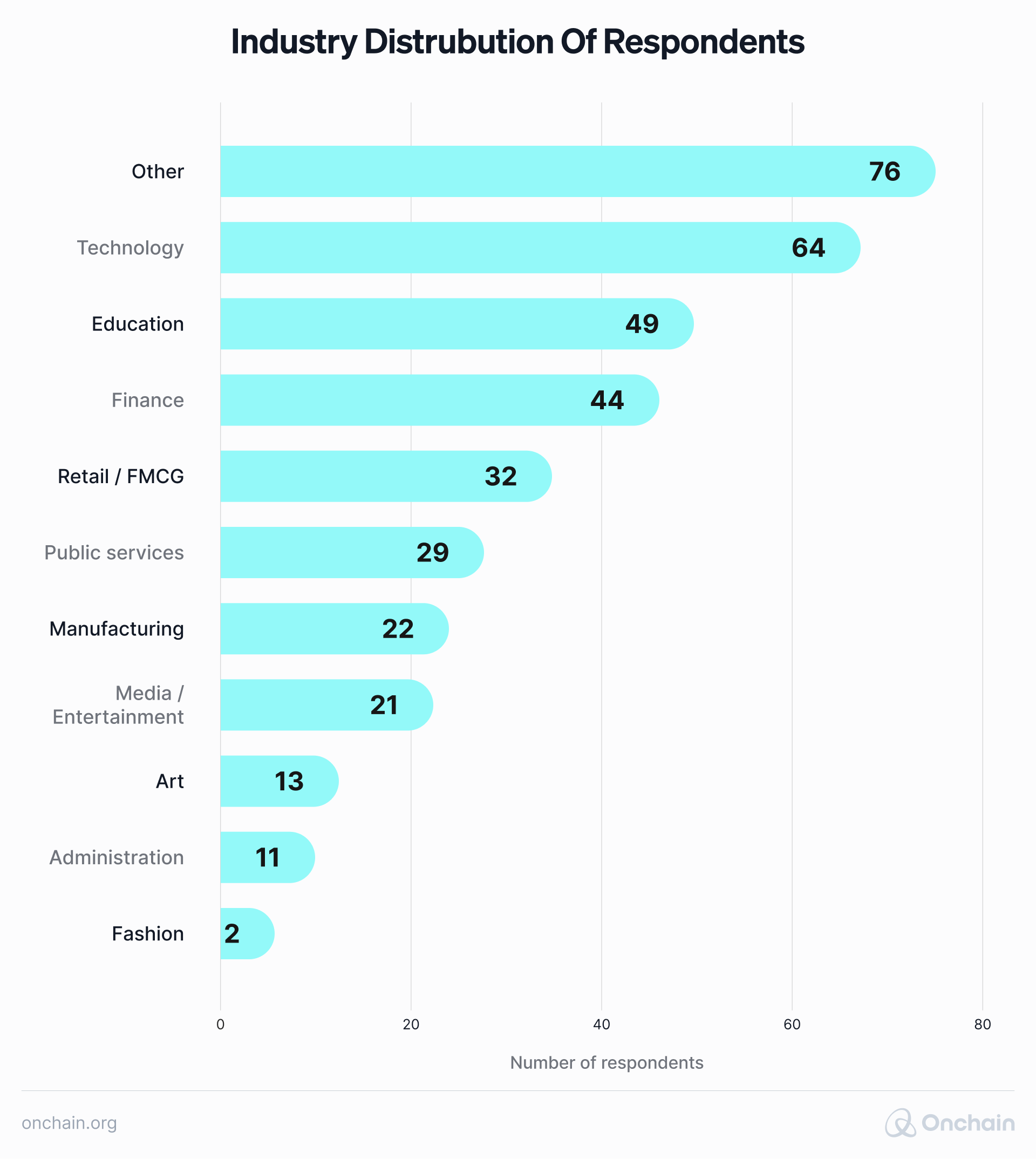
Led by
Conducted by




Ambreen Khral
Market Researcher
Contributors






